Hot War by Hostile V
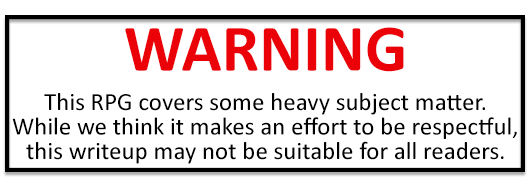
INTRODUCTION
Original SA post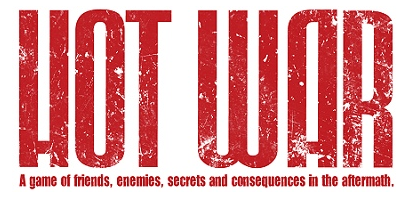
INTRODUCTION
Hot War is the followup/sister game to Cold City. It takes place in Britain in 1963, one year after the Cuban Missile Crisis goes horribly wrong due to the fielding of Twisted Technology instead of nuclear armaments. I won't be going too deep into detail here, this is just the introduction.
What Hot War does different from Cold City is that it uses a lot of in-universe documents to tell a story and it keeps the specifics of the story on the vague side of things. I like the approach they take to it, so before I get into the guts of the game and the setting and environment, I'd like the first update to be a collection of these documents. The following all preface the current setting, from roughly October 1962 to November 1963 give or take. These pictures are taken from Chapters 1 and 2.
COPY OF CONTENTS OF RECOVERED DIARY
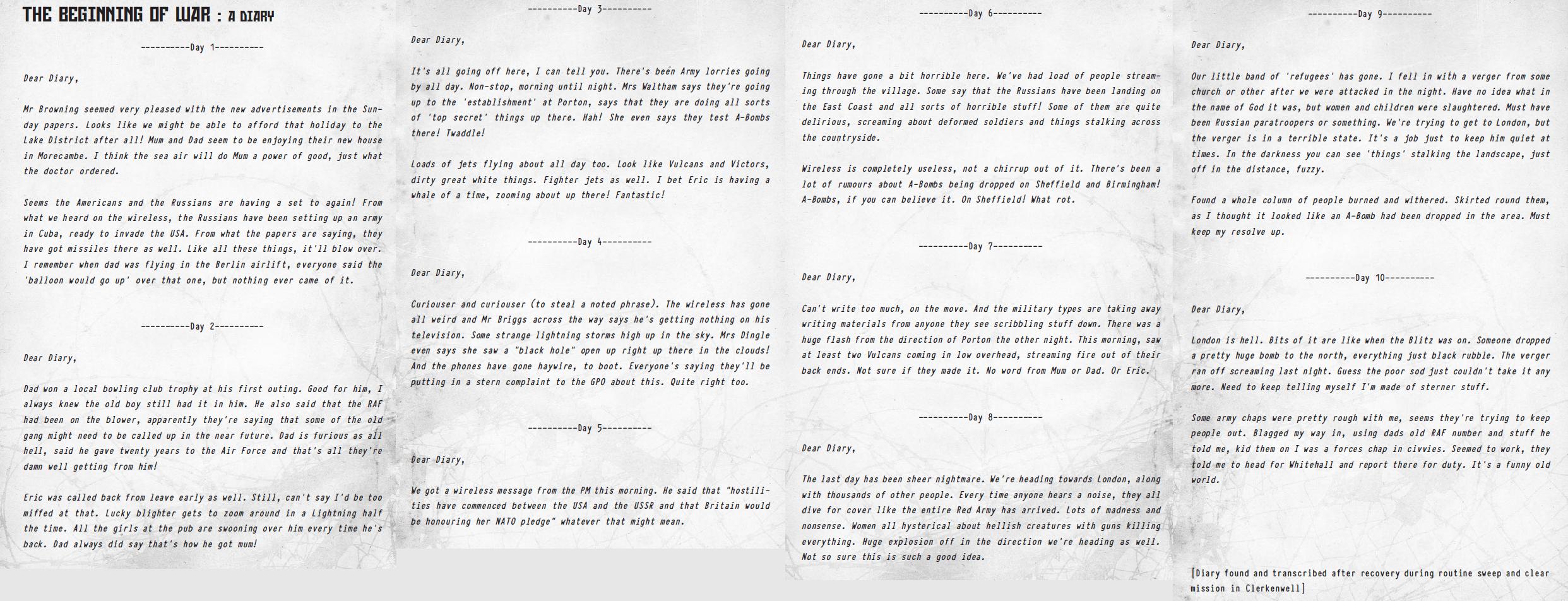
PUBLIC BULLETIN
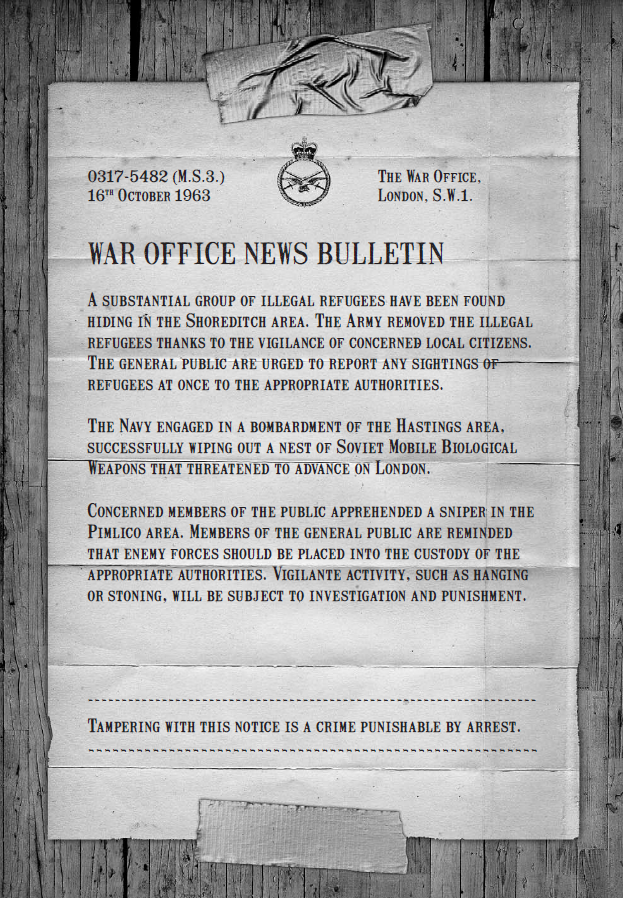
UNPUBLISHED NEWS ARTICLE
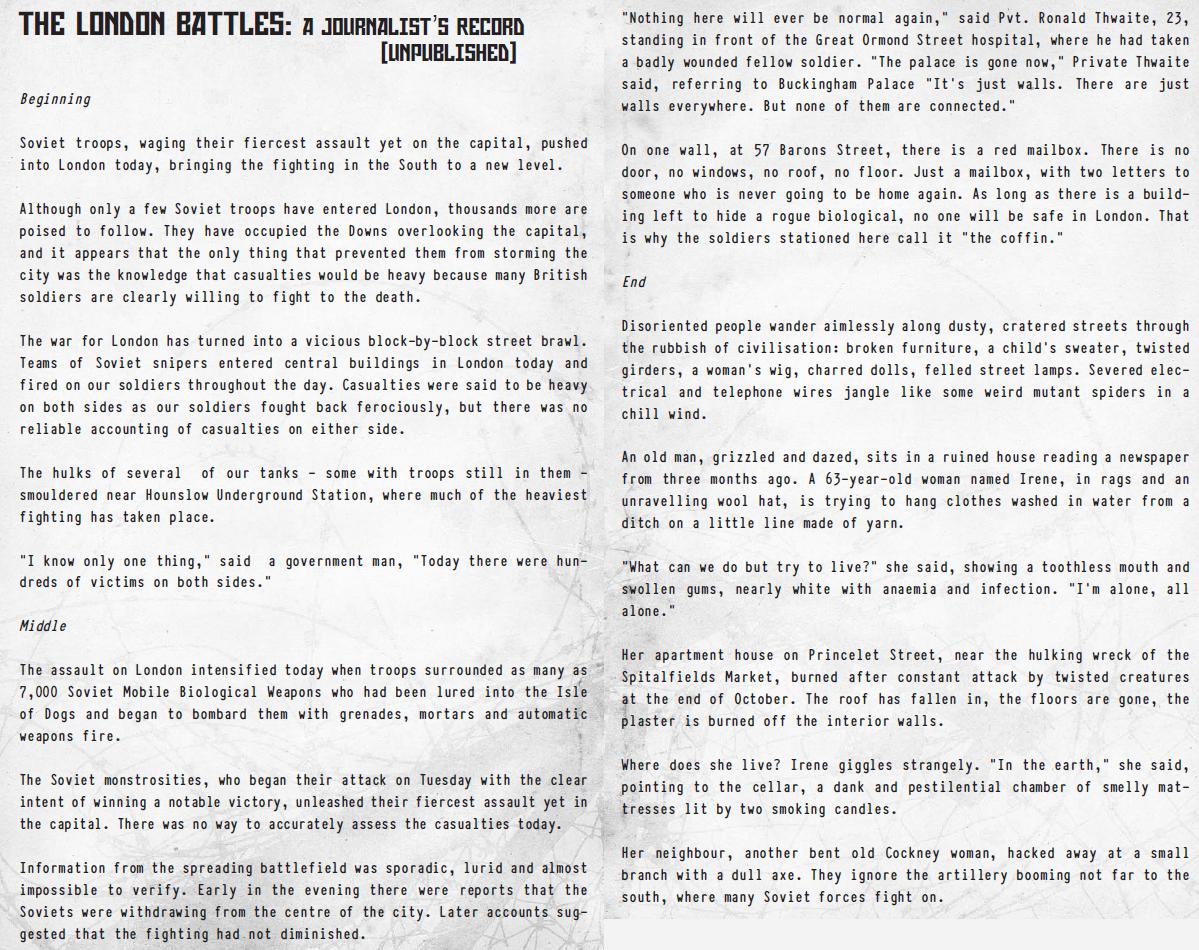
PUBLIC & PRIVATE ARTICLES, 1962-1963
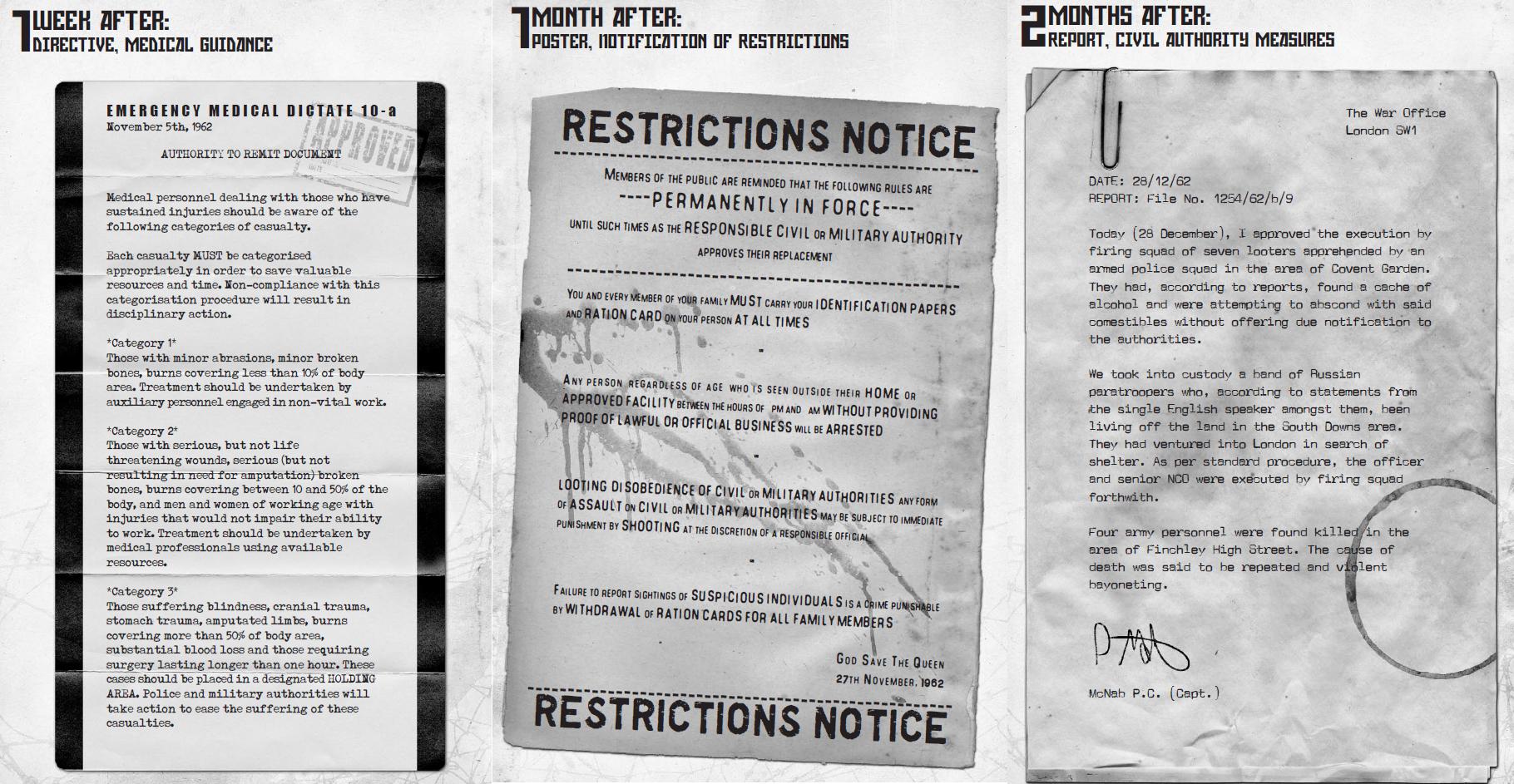
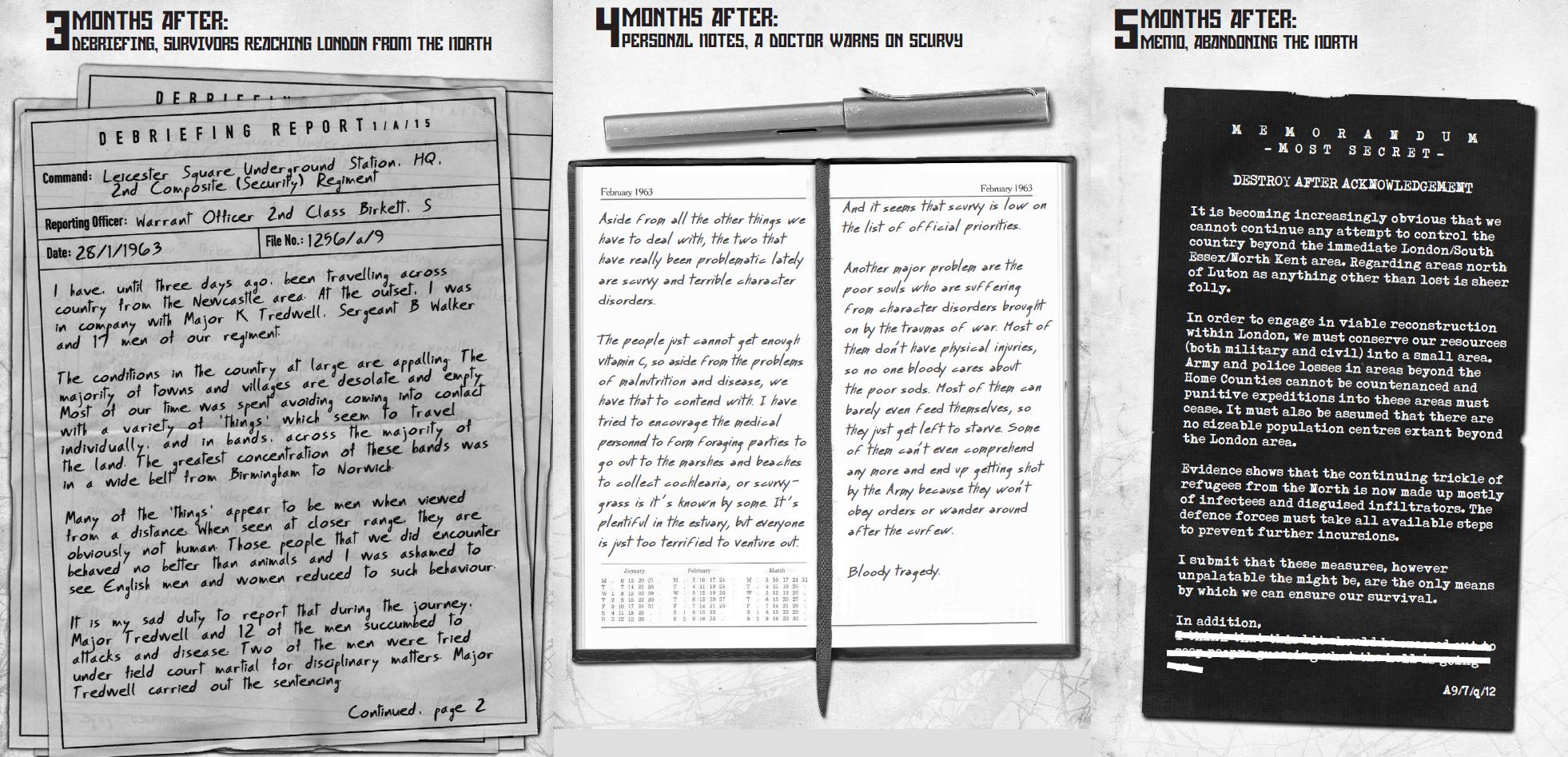
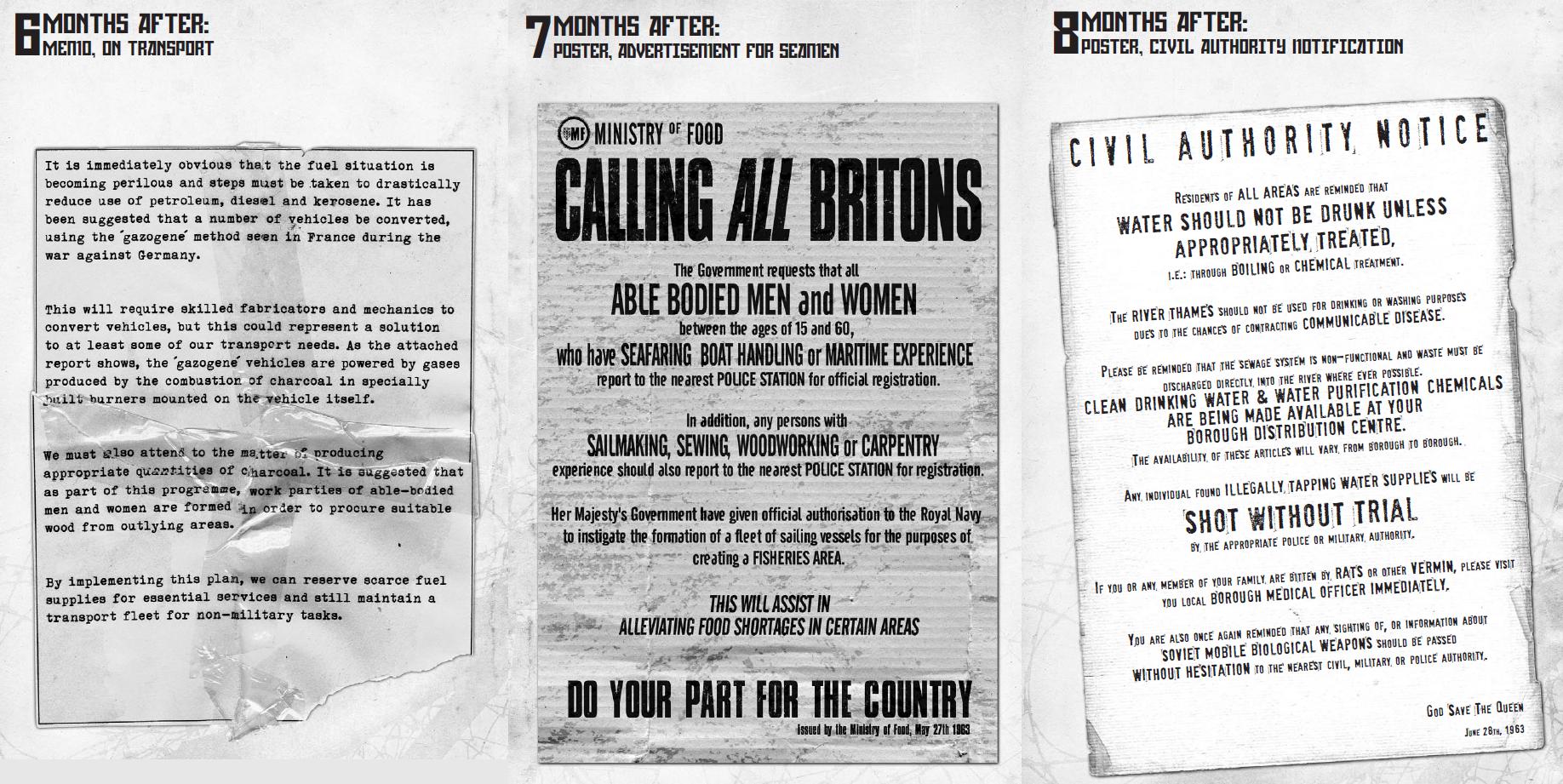
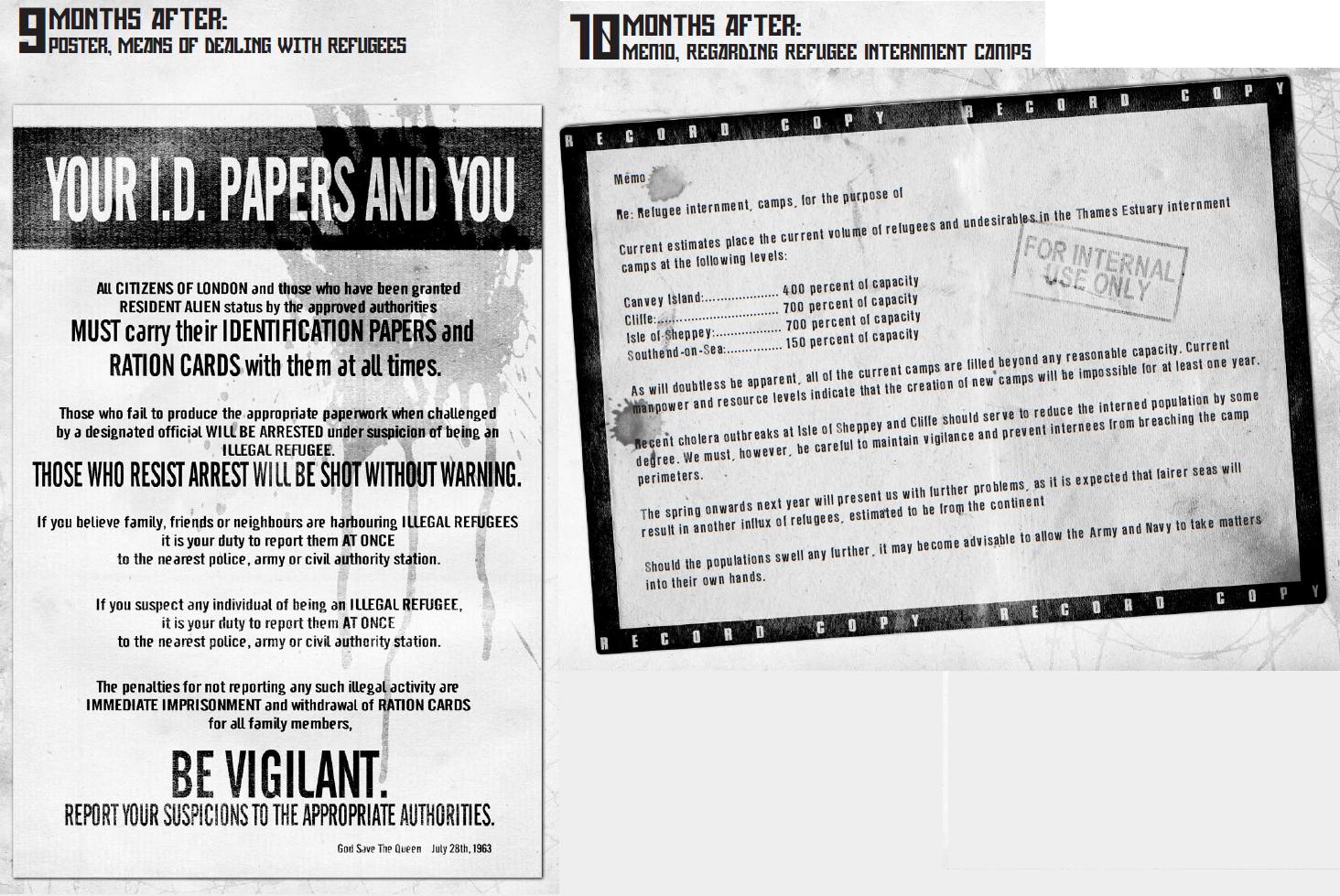
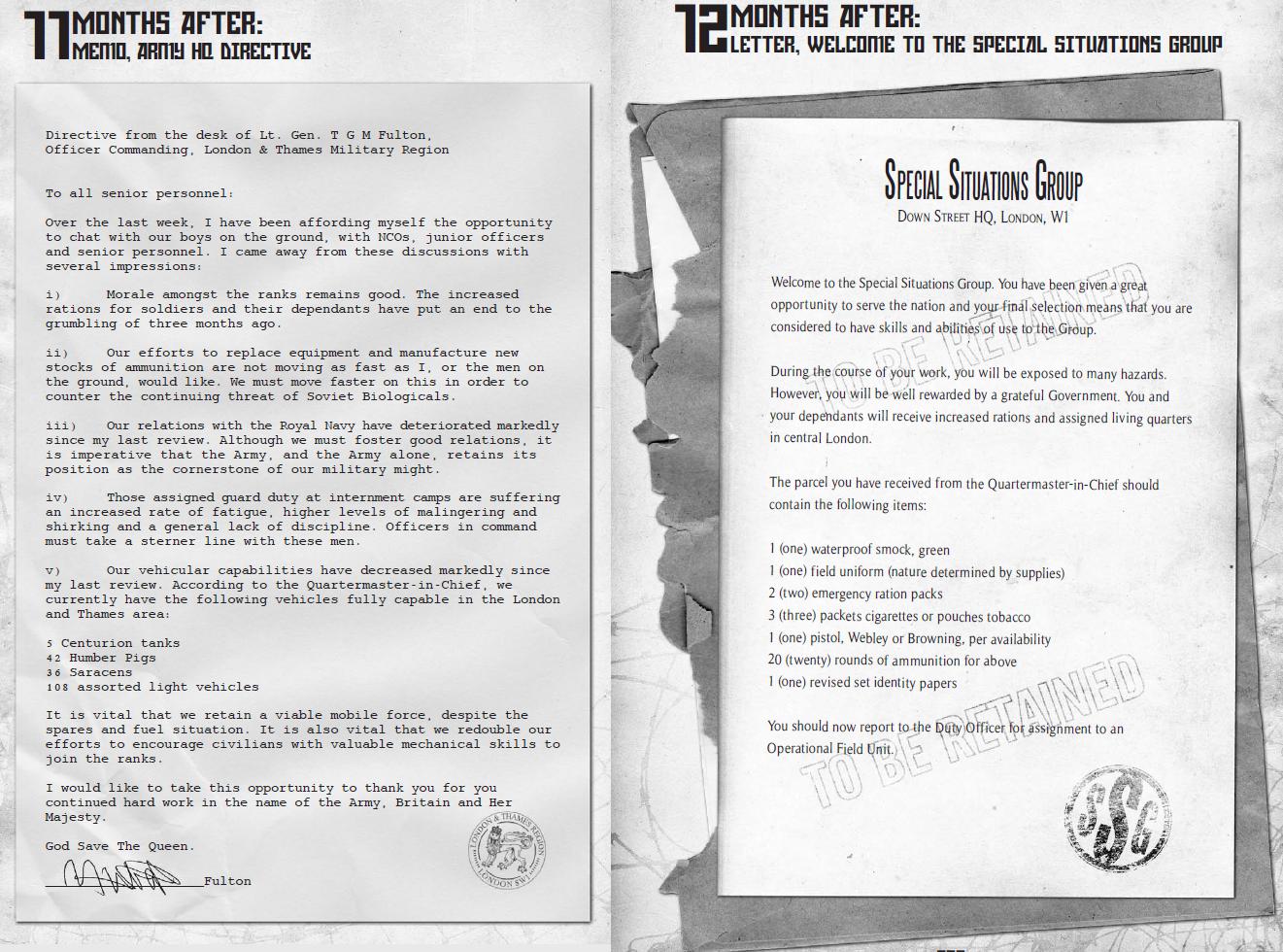
NEXT TIME: the beginning of the review proper.
CHAPTER ONE, CHAPTER TWO
Original SA post
CHAPTER ONE
Chapter one is the introduction of the game. Hot War takes place in London around October 1963, one year after the Cuban Missile Crisis lead to invasions and the firing of missiles. The winter of 1963 is going to be worse than 1962; the last year has seen the majority of Britain die, the infrastructure is breaking down and rationing is mandatory. The player characters are all survivors in Britain working for the Special Situations Group, a euphemistic name for a group of civilians, police and military working together to kill the monsters and stop the bad guys. Like the RPA, the different groups of London are setting aside their issues to try and work together. Also like the RPA, the different groups of London are trying to use the SSG for their own ends and to spy on each other.
Chapter one is also home to how and why Hot War was written. What it comes down to is that the author (Malcolm Craig) is interested in the artifacts of the Cold War and World War II: bunkers and buildings in the UK that had two purposes through most of the 20th centuries. He’s also interested in the conspiracy theories and the “what if”s of the Cold War. The game is also partially homage to the genre of the British Catastrophe, describing it as splitting the difference between the “misnomer of the Cozy Catastrophe often applied to Day of the Triffids” and the slow, brutal death of On The Beach. A lot of the environment is set up to be one of desperation and survival horror, but the setting is very much one for the GM and players to alter with what they want to play. Essentially he wants the world of Hot War to be one of Fallout instead of Unhallowed Metropolis; like the former, the world can survive and adapt if they work together, unlike the latter if they try and stay stagnant then the people of London are doomed. The history is laid out in the documents I’ve shared and other documents in the book, and some of the groups and monsters are fleshed out, but the book isn’t really going to hold your hand and make you live it. Craig has told the story he wants to tell and it’s up to everyone who plays it to take it in their own direction.
On that note, I’ll be sharing pretty much everything hook-related, probably at the end of each installment. Pictures of paragraphs, regular pictures and epistolary things will be included.
Chapter one also has terminology and what you’ll need to play. That’s pretty much it for chapter one.
CHAPTER TWO
THE HOT WAR
A lot of what was presented in this chapter was in the introduction. The first big chunk of this chapter is the diary, the article and the documents. I have no idea what exactly happens, and the game is built around building on these implicit aspects of history, so let’s get to what we do know.
The world powers disband the RPA after a few years once Berlin is stable and picked clean. The Cold War begins in earnest and the nations of the world start working on building their nuclear arsenals. Ultimately, the work on improving nuclear weapons and Mutually Assured Destruction was the cover story for the USA, the USSR, France and Britain. The four countries worked on their recovered Twisted Technology, getting deeper understanding of the things they’ve recovered. The plan is for nuclear weapons to be emergency option; if things get heated, they’ll start with the Twisted weapons first. The whole affair is kept beyond top secret in the echelons of every military, scientific institutions end up becoming cultish to work on the Twisted Technology, and everything comes to a head over the Cuban Missile Crisis.
What’s not clear (and intentionally not mentioned in the book) is who fired the first shot on October 27th. It’s believed by the military of Britain that it was either the Americans or the Russians who attacked first, but Britain was called to help America and they complied. The Twisted weapons landed in Poland, Germany, France, all over Europe and the world. They were without reason, unable to be fully controlled or understood. The gate machines of the Incursors were weaponized in airbursts and created aching wounds in the skies, ships ran aground on beaches and unleashed legions of the walking dead, sleeper agents released the Alternatives being kept in captivity.
What’s bad is that it worked. What’s worse is that it worked too well. The idea behind the Twisted weapons is that they would be clean and free of the moral implications of nuclear war, that there would be no worry about residual damage (like the neutron bomb, but with monsters). But the tears in the sky got bigger. The things that came through or were released couldn’t be stopped. And someone in a silo or in a governmental building panicked and fired the nukes.
Europe was definitely hit by nuclear weapons and so were parts of Britain (but not London, the nukes missed London). Countries starting bombing themselves to put a stop to the machines that launched the Twisted weapons. The RAF ended up panicking and enacting what the government called Operation INDIGO DIAMOND when they saw what was happening to the world and dropped a YELLOW SUN thermonuclear warhead on Porton Down, blaming their R&D for what happened and claiming that something was coming from the facility.
In the aftermath, Britain was cut off from Europe and from all of its allies. The world outside of Britain is unknown because the country is too focused with keeping itself together. The plan is to stabilize Britain before they venture back out into the world again. And for that, they need the Special Situations Group.
The SSG was put together a few months into 1963 as a matter of necessity. The surviving government had to reorganize and figure out how to deal with the immigrants and food shortages. Due to the insular nature of the surviving groups, they pooled some of their resources to fight. Unfortunately, the SSG's mission statement and scope is pretty vague. They're responsible for dealing with Twisted Technology, monsters and bad guys, which makes some sense, but then they're also tasked with counter-terrorism, which is a debatable sort of threat. This has lead to jurisdictional issues with the police and the military.
It's not hard to recruit for the SSG. They get better rations, they get guaranteed and secure lodgings and they get to help protect the people around them. Alternately, they're volunteered and can't protest being reassigned. The majority of the SSG is made of people from the military and from the police, and as a result there's a loose of sense of rank that the structure of both actively enforce. Everyone else is a civilian survivor and they can be from any walk of life, from bureaucrats, truck drivers or doctors. From there, the members are divided into three different divisions. A Division is command, controlling the stores and armory and workshops. B Division (or "The Backroom Boys", which is an unfortunate name) is full of bureaucrats, scientists and engineers who don't go out in the field. C Division (or the Player Character Group) has Operational Field Units, three to six people who do the field work. Members of the SSG have some governmental powers too; specifically they have the right to carry weapons and the right to arrest and detain. This is a nebulous degree of rights and freedoms and there's a heavy overlap with the military and police and this leads to conflict across the board.
FACTIONS
Government: The government likes being in control and they don't want to give up control. Their main goal to stop the military from inflicting total martial law and maintain the status quo.
Other political parties: Use the SSG to dig up dirt on the incumbent government to get more power. They're pretty fractured themselves with the Union Movement having a sizable power base. Despite their name, this is a bad thing; the Union Movement is a nationalistic crypto-fascist populist right-wing group that has nothing to do with actual unions.
Terrorists/Underground factions: Anti-government, anti-police, anti-military, violently or nonviolently so. Some of these groups are simply pro-refugee while others just want to blow it all up. They've placed sympathetic individuals into the SSG to help their groups get some leniency or undermine the government.
Army: The Army wants to be the biggest power in London. Their big goal is to surpass the Navy in means of power generation by retaking the power stations and starting up mining and forest-clearing again.
Navy: The Navy still thinks of itself as the best of the best and it really is one of the dominant powers of the moment. The guns of the battleships are still loaded, a nuclear submarine is being used to help power facilities in London and they use their boats to fish. Their ultimate goal is to get the rest of the nukes away from the RAF and stop the Army from wasting all the gasoline with their tanks and vehicles.
RAF: Ever since the RAF nuked Porton Down, they've been a laughingstock. The RAF is trying to absorb the BERB and is also waging a propaganda campaign to become the big brains of the military, hoarding all of the information and helping people to look better. Also they want to keep all of their nukes, thanks.
The Police: The police of London are made up of transport police, Metro and London PD. They really just think that the SSG's power is too ill-defined and loose with applications of its powers. The police would like to absorb the SSG wholesale and subsidize it, and it doesn't help how many cops are in the SSG.
Intelligence Groups: MI5 and MI6 are acting shady and haven't infiltrated the SSG as much as anyone else has thought. The spies are really just busy being mysterious and doing their own thing and there's the fear that they're full of surviving Soviet moles turning the intelligence divisions into weapons against London.
American Forces: There's a small group of American soldiers (mostly USAF) who have no idea what happened to America and desperately want to find out. They're helping the SSG to curry the favor of the RAF or the Navy to get them on their side and convince them to reach out to North America and find out what happened to their families and their country.
BERB: A lot of the scientists (including the Professor) ran to London when the war started and managed to avoid the nuke. What they were responsible for became public knowledge and now everyone hates the BERB, turning the group into a scapegoat for the war and everything that went wrong. Their big goal is less "make people like us" again and more "take the Twisted Technology out of the hands of the military and study it again". That didn't go so well the first time but maybe this time they can figure out how to reverse things.
NEXT TIME: Chapter three, making characters. You may think that everything is wholesale copied from Cold War, but fortunately there are some changes so I don't have to just skip this part. And now, pictures!
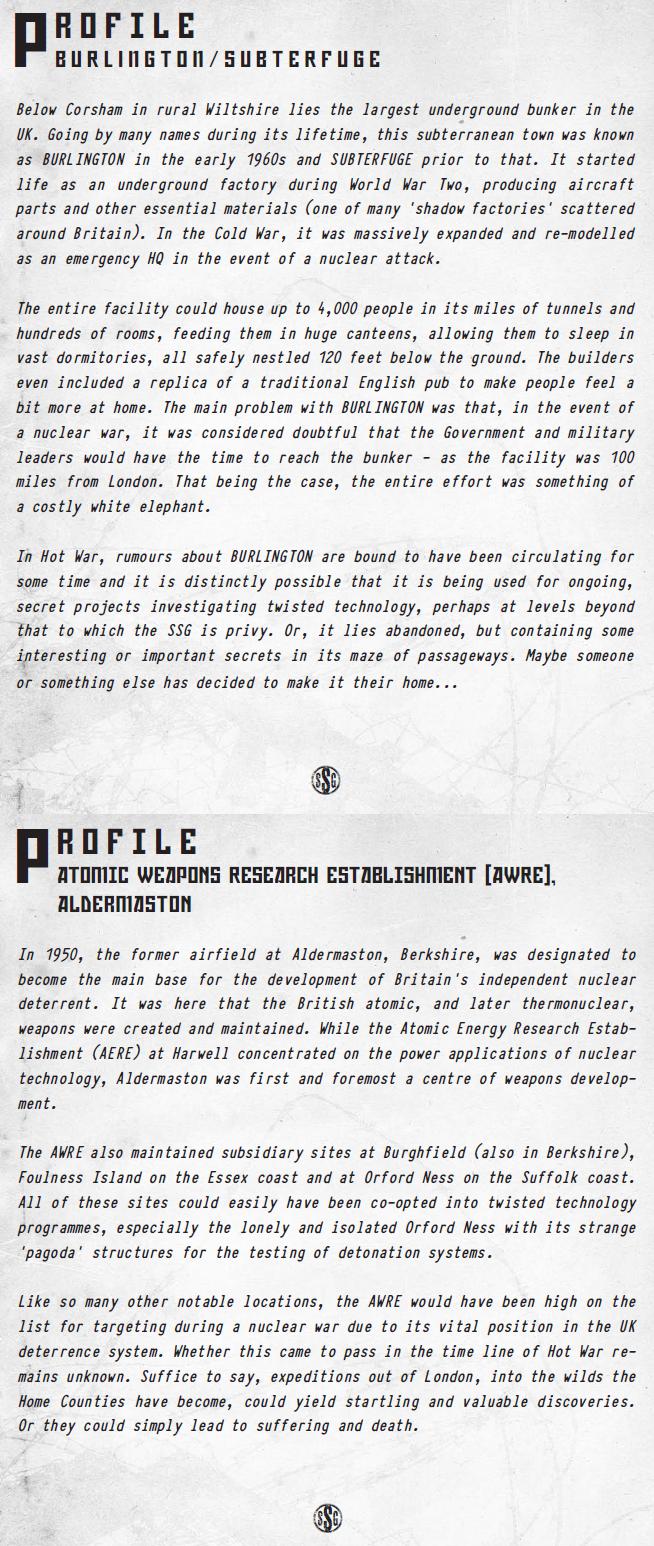
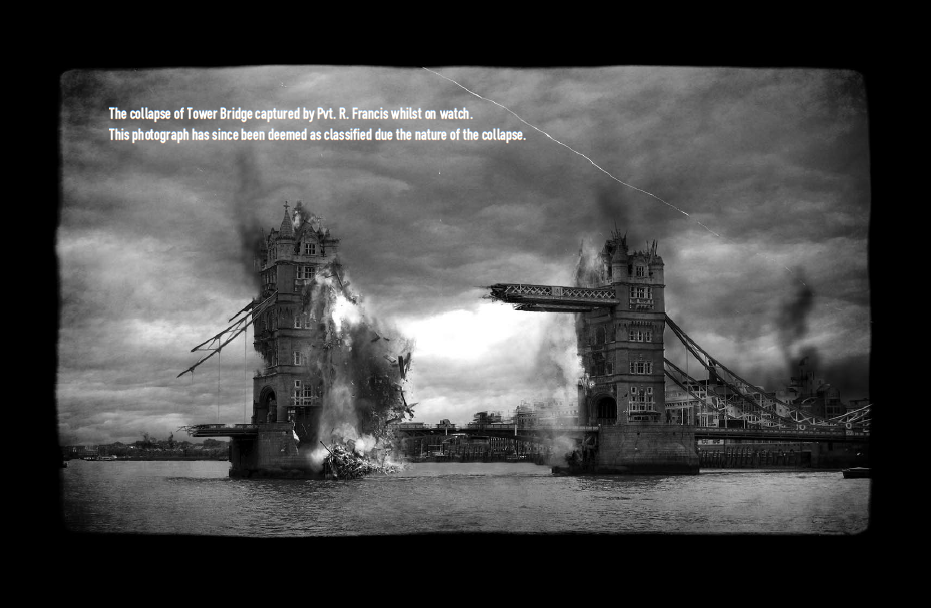
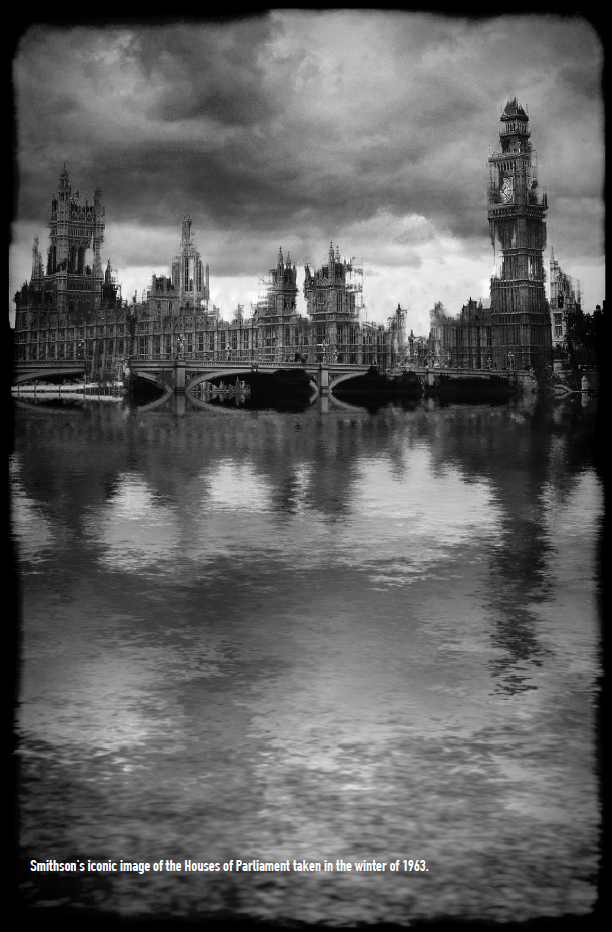
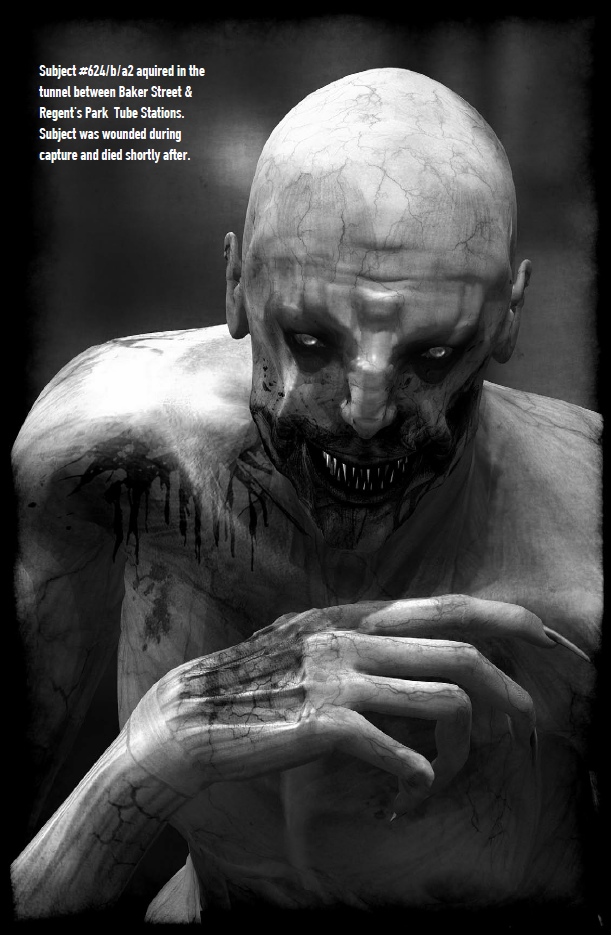
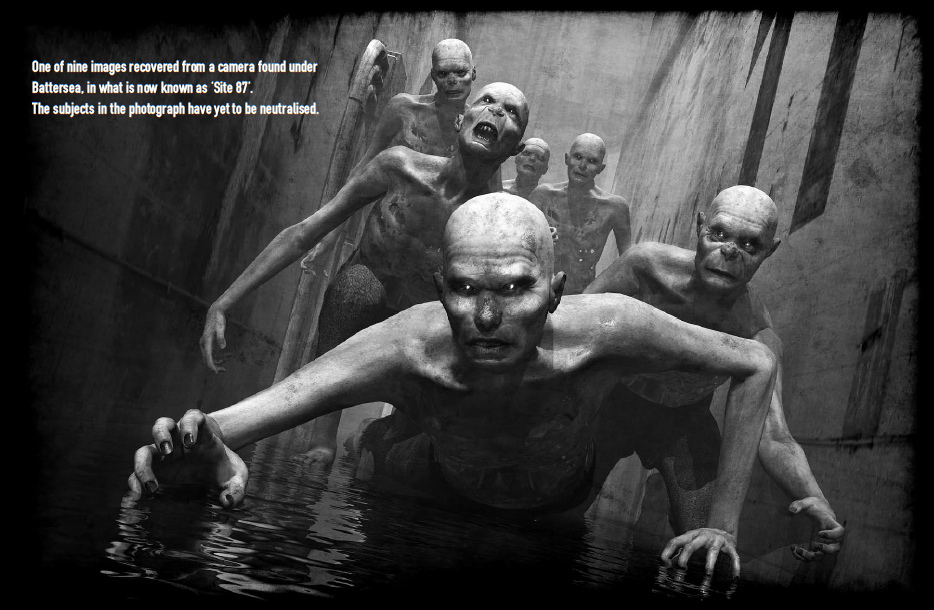
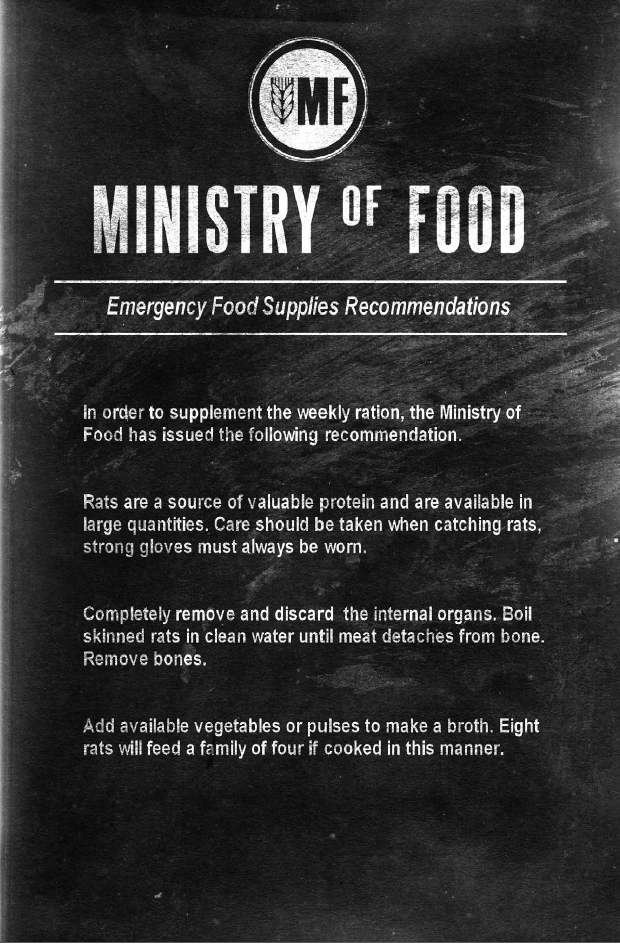
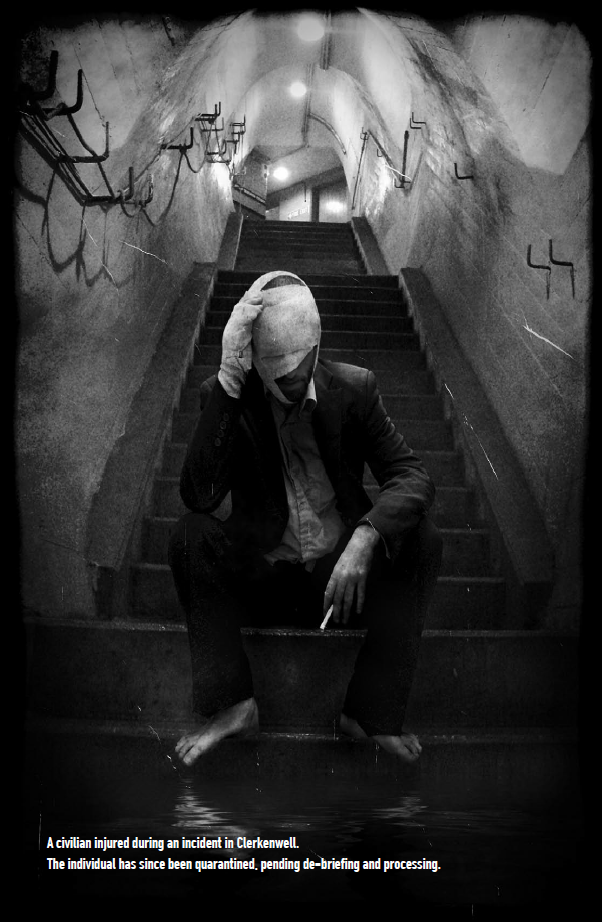
CHAPTER THREE, CHAPTER FOUR
Original SA post
CHAPTER THREE
Creating Games and Characters
There's a lot of overlap between Hot War and Cold City, but fortunately there are some changes. Setting up a game and characters is consolidated into sections that break down the responsibilities of the players and the GM. Again, creating a game is both the duty of the players and the GM having a jam session. The guidelines are below.
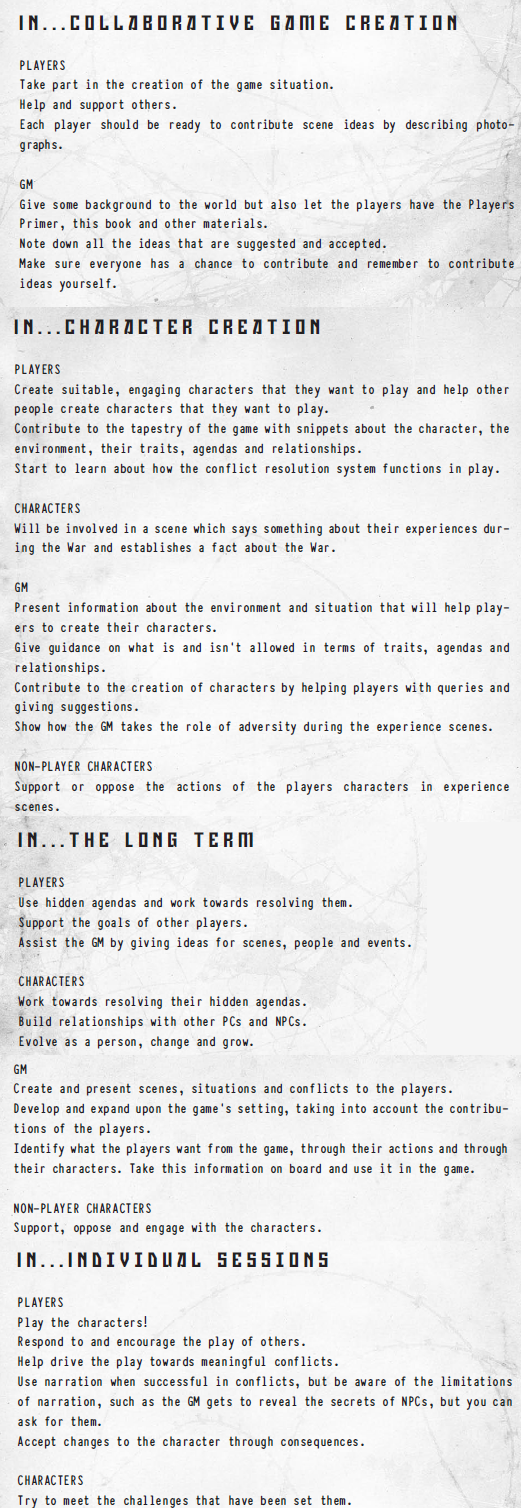

There are still Closed and Open Games with the general structure of the game leaning more towards supporting Open Games for the sake of streamlining play and being more collaborative. There are also recommended Tones and I do like the thread-suggested idea of adding a dash of trippy stuff, even if the game doesn't put that forward as a suggestion.
SAMPLE GAME TONES
- Quality BBC Drama:
- What are the characters doing?
- Who are the antagonists?
- Who else is involved?
- What scenes do we want to see?
- How long do we want the game to last?
Character creation follows the same rules of Cold City with light changes. For starters, Hidden Agendas are different.
You still take one Personal and one Factional Agenda with the former focusing on things your character wants and the latter focused on what your superiors want you to do. The only real restriction is that the Agendas must be imperative; they must be active and compel the character to do something. Agendas now have RATINGS which are used as a way to gauge how important and fast the Agenda should be completed. The ratings are 3/5/9 and are selected when an Agenda is created. A Rating 3 Agenda can only be used three times before it should be resolved, but you get a +4 dice bonus when it's called on because it's getting the brunt of your focus. Conversely, a Rating 9 Agenda can be used nine times but only confers a +2 dice bonus to your pool. The Rating 5 is five times with a +3 bonus. Agendas should only be used when appropriate and when they're used up they require a conclusion scene to wrap up the whole affair. You can take both of your Agendas with the same rating, but in a long-running game you can't just keep picking Rating 3 Agendas; all three types of Agendas must be completed before one rating can be used again.
TRUST is out and replaced with RELATIONSHIPS. Relationships are sort of like Trust, but the big difference is that Relationships affect NPCs, not just PCs. When making a character, the character must have one of the following:
- A relationship with one other member of the team.
- One relationship to their faction, which can be to the faction undivided or one specific person within it.
- A relationship with someone in their personal life (loved ones, friends, relatives).
- A relationship with someone who qualifies as an antagonist or "someone else involved" when game creation was being done.
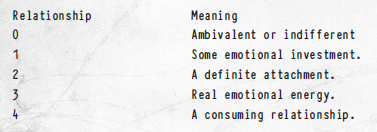
Positive Relationships: Trust, love, friendship. Gain a bonus to your dice based on the relationship if they're being used to support/help/empower someone or to strengthen the bonds of that relationship.
Negative Relationships: Distrust, bad feelings, destruction. Gain a bonus to your dice if your relationship is being used to bully/harm/disempower or if you want to make the relationship less negative.
More specific rules about using relationships in the dice pools are included in chapter 4. The rest of chapter 3 is just explaining the Experience Scene, which is the Draw Scene from Cold City but renamed.
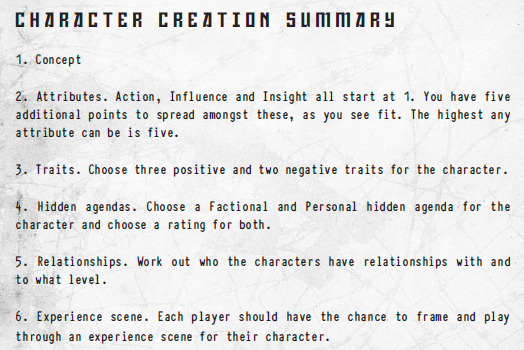
CHAPTER FOUR
Playing the Game
Framing scenes and resolving conflicts are the same as Cold City, but there are some new touches to conflict scenes.
For quick or unplanned opposition, the GM can simply assign the enemy a pool of 3/5/7/9 dice depending on how competent or challenging they are, bypassing the need for the GM to stat them out if it's not really important for them to have traits. Hidden Agendas don't have any changes for creating dice pools that weren't previously mentioned. Traits also function identically to Cold City including the rule for succeeding with a negative trait being a "yes but" result. Relationships are different from Trust substantially.
In Cold City, Trust was used two ways: call on someone and use the trust you have in them as dice, betray someone and use the trust they have in you as dice. A Relationship can only be used if it has a direct impact on the conflict or may influence the relationship. You can't use how much you hate your dad to motivate you to catch a running criminal unless your dad is involved. Relationships also are at risk of being altered like Traits when brought into play. Positive and Negative Relationships have specific uses, but they also have specific catches depending on who brings the relationship into play and if the people involved are around.
With a Positive relationship, the character who owns the relationship gets the first choice to use it if they wish. With a Negative, the other participants get first choice to use the relationship for dice, not the owner. In either cases, whoever gets first choice but doesn't pick it means the other participants in the conflict can use the relationship.
However, things change if the conflict is with the object of the relationship. If it's Positive, the owner of the relationship is the last person to get the choice of using the relationship. If it's Negative, the owner of the relationship gets first choice of using the relationship against the object of their relationship. It's written a bit unclear and it's a tricky phrasing of this whole thing, but I get the idea behind it and I like the idea of it.
Finally, there's a new important step added. Anyone player not involved in the conflict has the ability to influence the final dice pools of any side as long as they can state a changing factor to the scene and why they're choosing to help or hinder. You can either add or subtract a single die and you can only do this once per conflict.
The same rules from before still apply to rolling the dice: whoever gets the most dice higher than their opponent's wins the conflict and the dice that are higher become successes. The same rules also apply for multi-faceted conflicts or working together as a group.
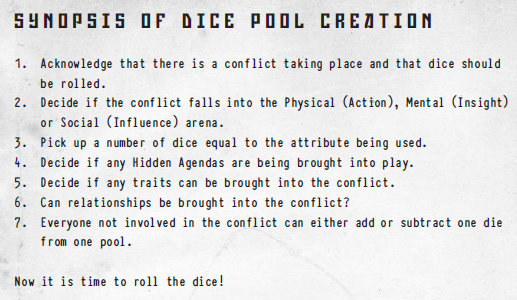
CONSEQUENCES
Because the mechanics have changed a bit, so have consequences. You still have success points to spend when the conflict is done, but the big change is that now you can spend points on changing Relationships.
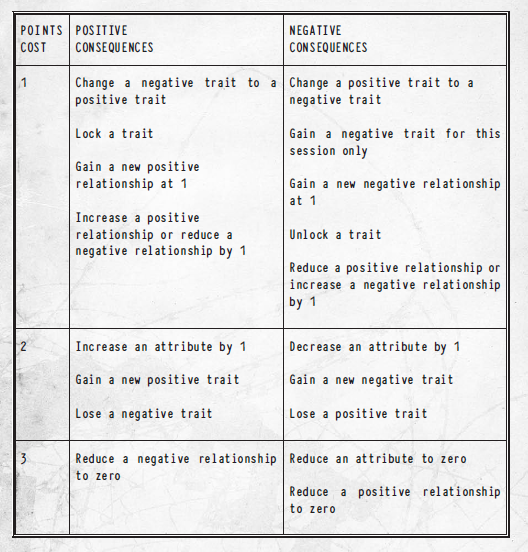
Finally, the rules for Crisis Points and resolving Hidden Agendas stay the same (not counting "you must make a new Hidden Agenda").
CREATING AND USING NPCS
The rest of the chapter revolves around making NPCs. If you need a quick obstacle, the early rules still apply: just give them a pool of 3/5/7/9 dice to use. But sometimes you need a NPC with more meat to them. There are two types of NPCs: simple and detailed. You also want to know if the NPC wants to help/get help from/oppose/use the PCs.
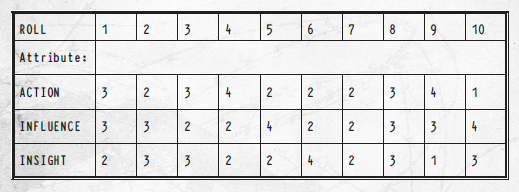
Simple NPCs get their stats from a roll on the above chart (like Cold City), get two positive and one negative traits and 3 Relationship points to use. They don't get Hidden Agendas. Simple NPCs can also come in groups, in which case they get +1 to +4 extra stat points to spend (depending on members, max limit is +4) and two more positive traits.
Detailed NPCs get 5 attribute points to use, three/two positive/negative traits, six points for relationships and Hidden Agendas (if not a National Agenda, they get two Personal Agendas).
A new rule added is asking yourself the question "is this NPC a monster?". This is not a literal thing; yes your NPC could be a monster by virtue of being a 9 foot tall acid-spitting Soviet lizard man but they could very well just be an awful, miserable person. A monster has lost some part of their humanity, gaining +2 points to use on their Attributes and an additional positive and negative trait at the cost of being horrible and despicable.
SAMPLE NPCS
Lt. Commander Trevor Barlow, RN: Barlow is the Navy's man for running the refugee camps. His decorations, xenophobia and zealousness for rounding up refugees make him perfect for the job and he's surprisingly young for his job. To simplify things, he is a gross son of a bitch and he should probably be killed by the PCs and replaced with someone who is less of a creep. If you don't like any of what I said, you probably should not read his Personal Agenda in his stats. He's a good idea for a villain but that's just a wholly unnecessary detail and a gigantic misstep I can't defend. If you use him, change his Personal Agenda.
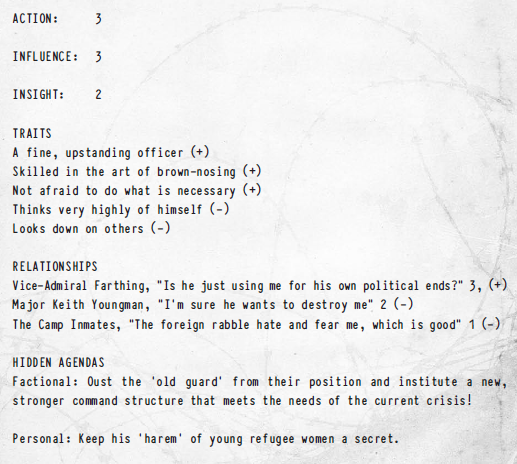
Mrs. Irene Joyce: Mrs. Joyce was a simple housewife a year ago, happy with her family and home and her angry, overbearingly Tory husband's political views. Then everything went to hell and her husband died. Irene now has turned against the government as a leader of a Citizens Defense Army cell, her cell assassinating government members and bombing locations.
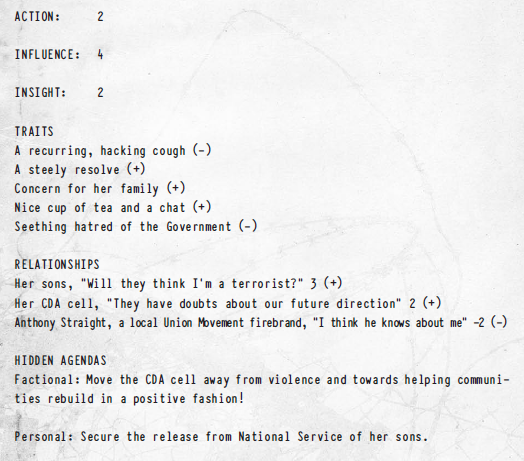
SAMPLE MONSTERS
Bayonet Troops: Bayonet Troops are Soviet Mobile Biological Weapons that look like humans in patched, awkward uniforms wearing gas masks and helmets, armed with bayonet blades. They are not human in the slightest up close: too many joints, wrong posture, no visibility with their masks. Bayonet Troops travel in packs, often at night, and gang up on lone prey to cut them to death. They've been captured in the past but can't survive without their helmets, their child-like faces gasping for the gas they need to breathe. A Bayonet Trooper's life is short: hunt until you die of starvation or from being attacked. London's scientists think they are completely disposable; they don't seem to know anything but hunting and fighting. If that's the case, then why are they still around a year later? Where are they coming from? Most likely source: Alternatives. The stats are for a squad of 5 Troopers.
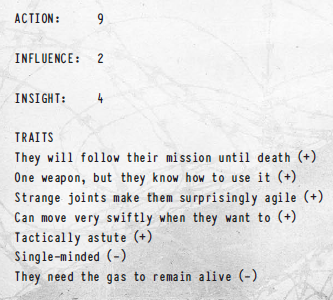
Creeps: Creeps look human too, clad in Soviet uniforms and resembling normal humans with a disgusting skin condition that seems to have sucked all of the moisture and oil from their pores. It's when they open their mouths that something is deathly wrong: Creeps speak in a broken, barely intelligible babble of Russian and can't actually be spoken to. Autopsy on them reveals that they are most likely the Soviet answer to STs with electrodes mounted on where the spine meets the brain and a wire that runs down the right side of their body beneath the skin. Creeps act like animals, fight like animals, but have animal cunning. They've been seen fighting the remainders of Soviet troops in addition to British soldiers. The worrying thing about the Creeps is that now they've started appearing in British clothing.
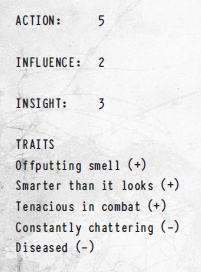
The Fear: Also known as Koschei, fear demons are a type of Incursors that are harmless and invisible until they find the perfect feeding ground. They were originally summoned by planting a mole with an Incursor machine raising the levels of paranoia and fear by spreading rumors, lies and distrust. The machines were activated and the Koschei came through, the ambient atmosphere nourishing them. The Soviets then trapped them in containers for later release as a weapon. The more fear is in the area, the stronger they get, eventually culminating in enough power to become corporeal and tear into someone with their claws, devouring their fear directly as they die and going on a rampage of gluttony.
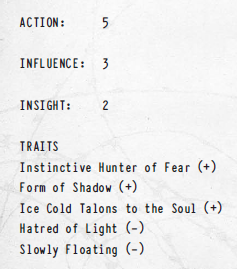
Runners: Runners can never be mistaken for humans. Seven/eight feet wide and six feet tall, the body of the Runner lies flat, supported by six to ten legs (counting their front two legs which can be used like hands) in a weird conglomeration of man and spider. Their heads and faces are replaced by the dangling tube of a lamprey, covered in eyes and full of razor-sharp teeth. They're durable and strong, ripping through barricades and hunting with demented precision. The worst part is that transmitting equipment has been found sewn into the bodies of some of them, wires running to their "heads" and broadcasting to somewhere.
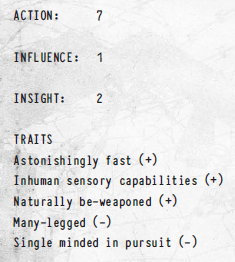
Servitors: Servitors are not from Earth. Servitors consume. They consume the trash they roll over, they consume all of the sound around them, you can't even look at them properly because they seem to consume light or even the ability for you to perceive their form. What survivors and scientists have been able to piece together is that a Servitor looks something like a flowing black mass that moves with the precision of an iceberg. Their weight is immense, crushing everything in front of them, leaving no trash in their wake. There are rumors that the British were trying to develop their own Servitors and a nuke was dropped in the south to destroy a massive Servitor from rolling over London. This is a single medium-sized Servitor, which can be found at random in the countryside or in the Underground prefaced with carpets of rats fleeing from them. Servitors don't get negative traits, but they should get them related to the environment or situation around them. They're pretty much Shoggoths and how Stross was using them in A Colder War.
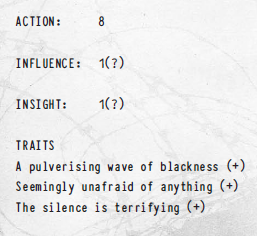
NEXT TIME: Chapter 5 (organizations) and probably all of Chapter 6 (London and Beyond) and the end of the book, probably. We'll see if I have to break it up but I'm approaching the end.
HOOKS
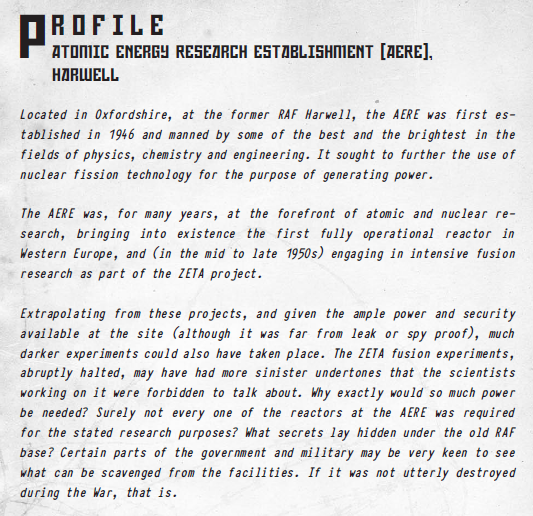
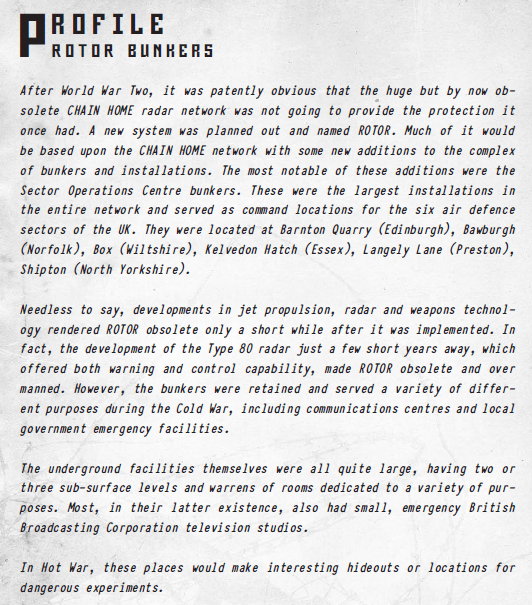
DOCUMENTS, POSTERS, FLYERS
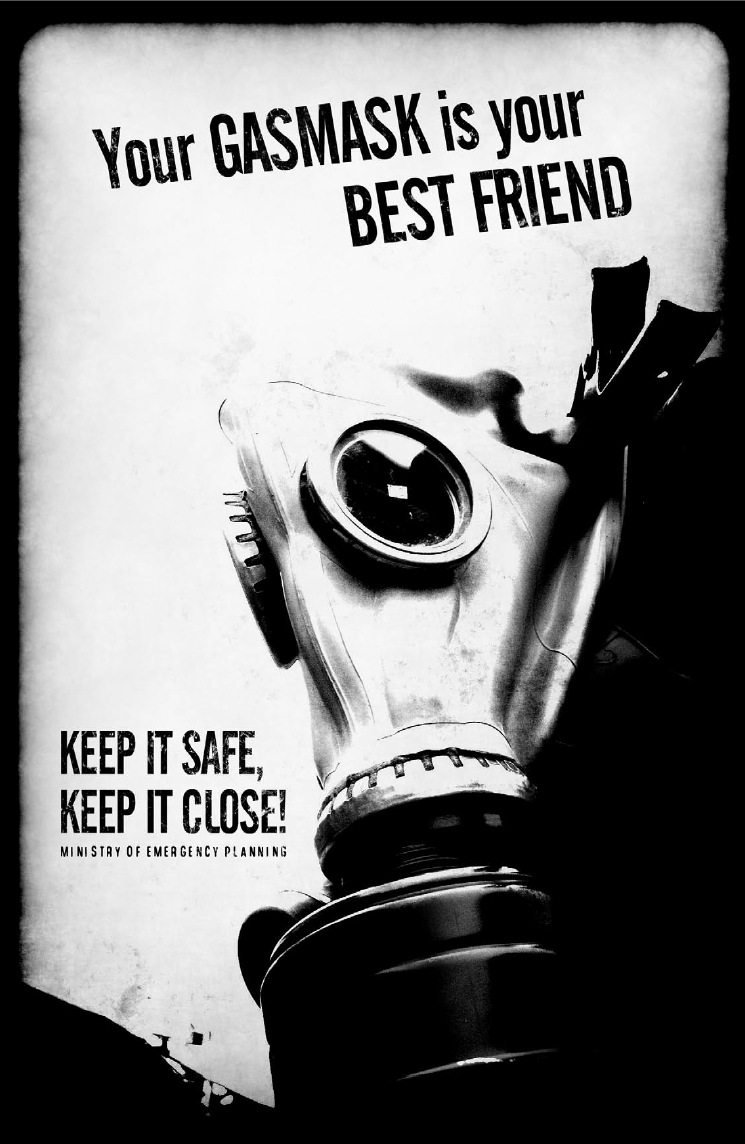
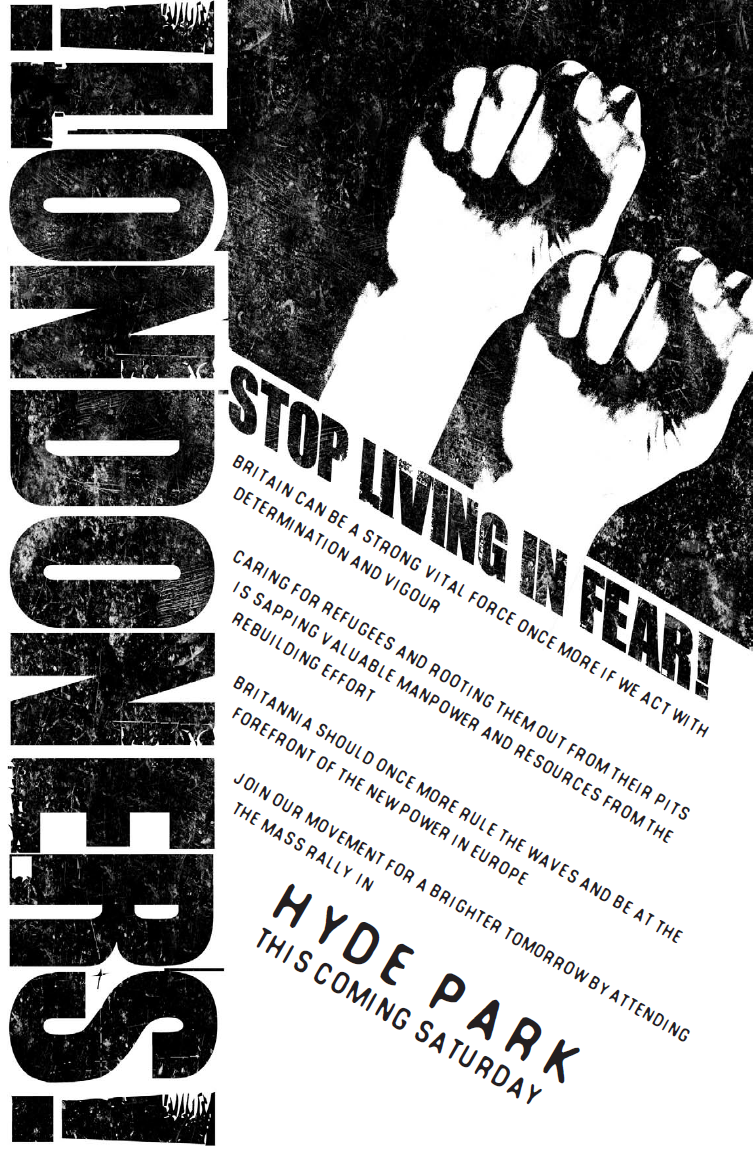
Most likely a Union Movement poster.

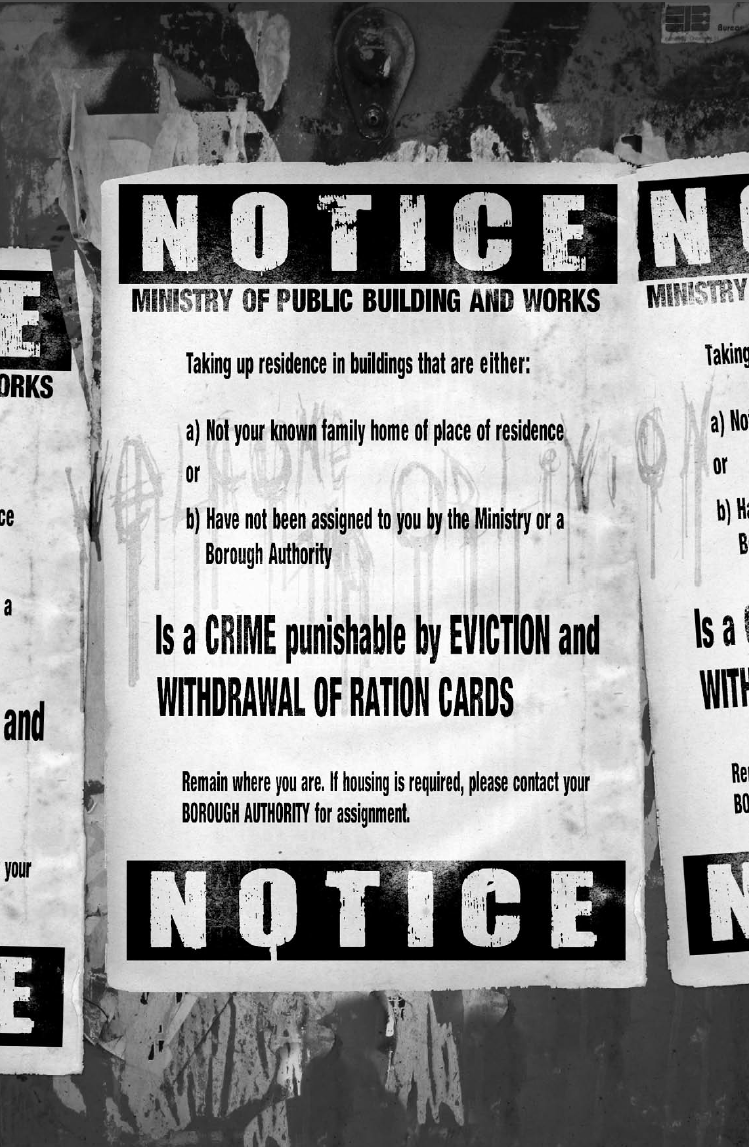
PHOTOGRAPHS
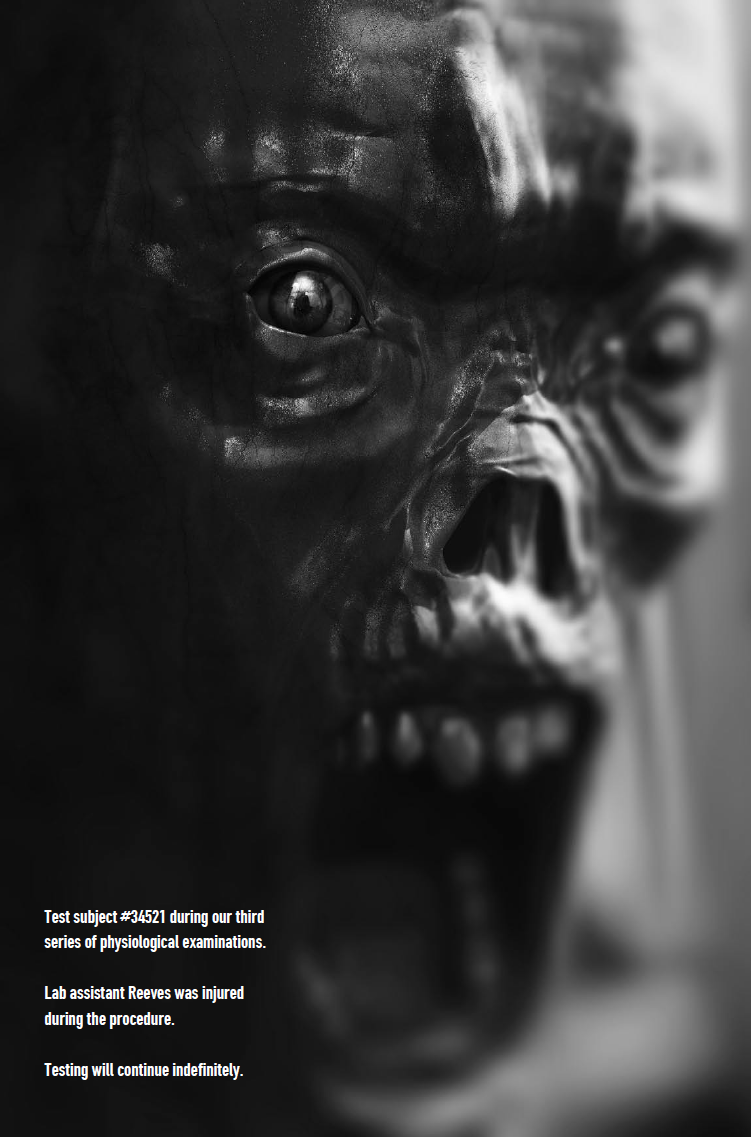
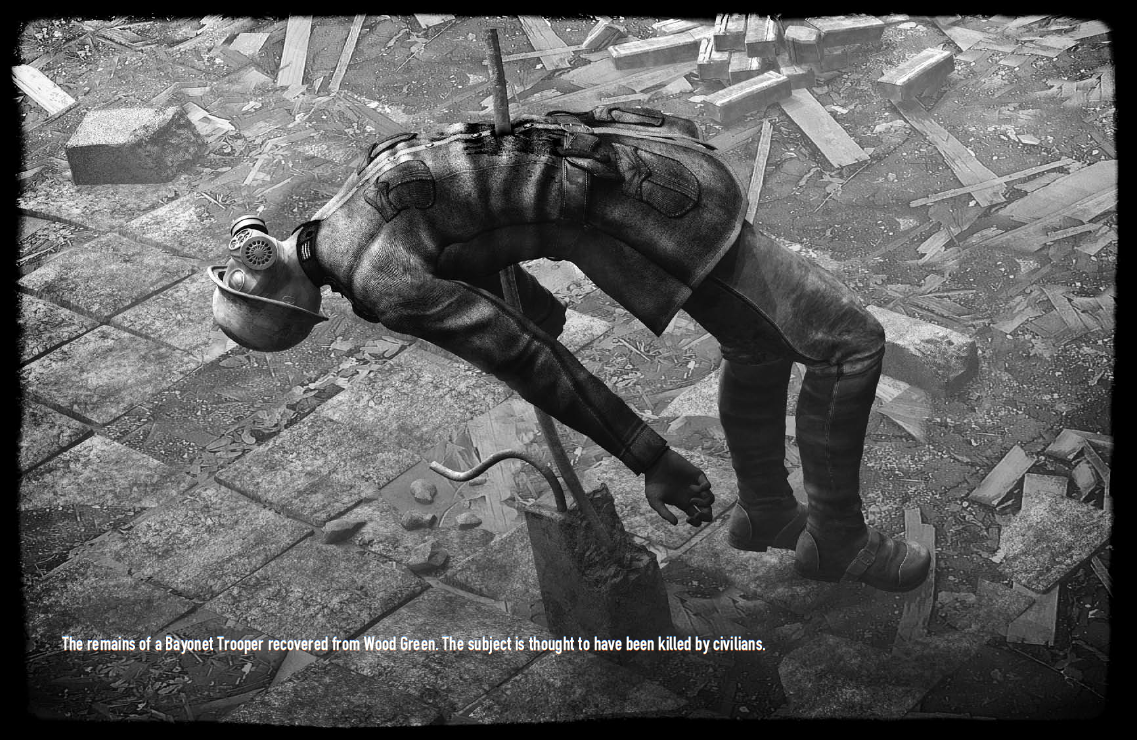
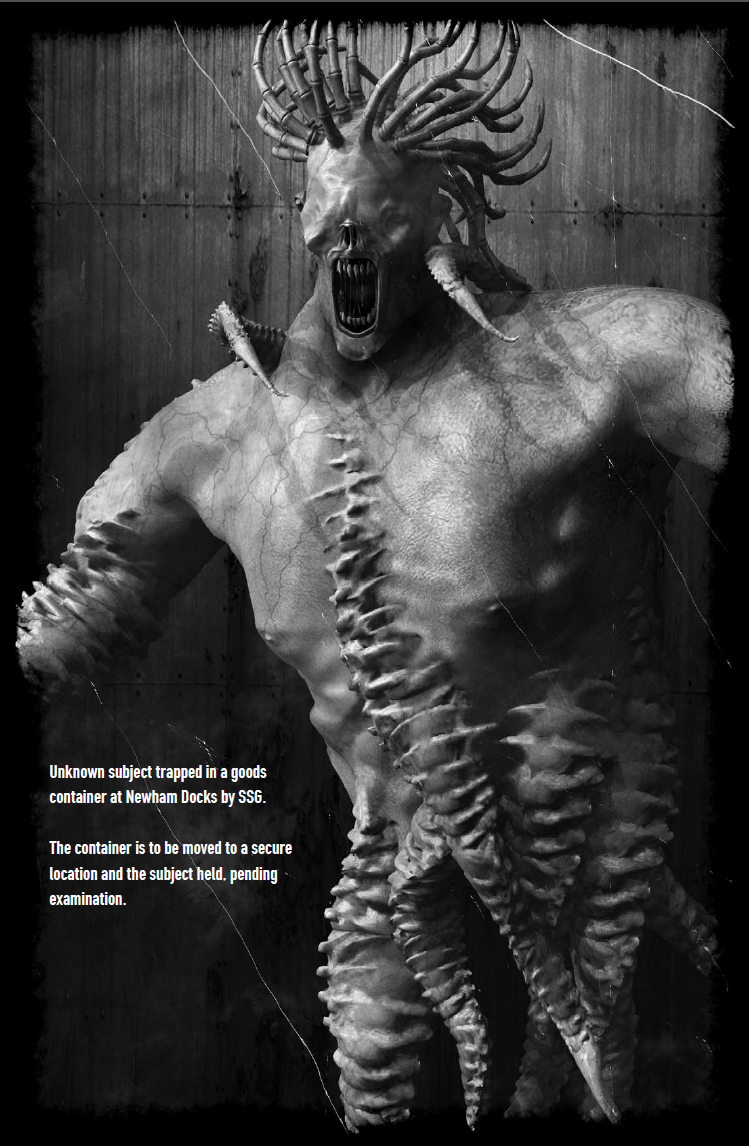
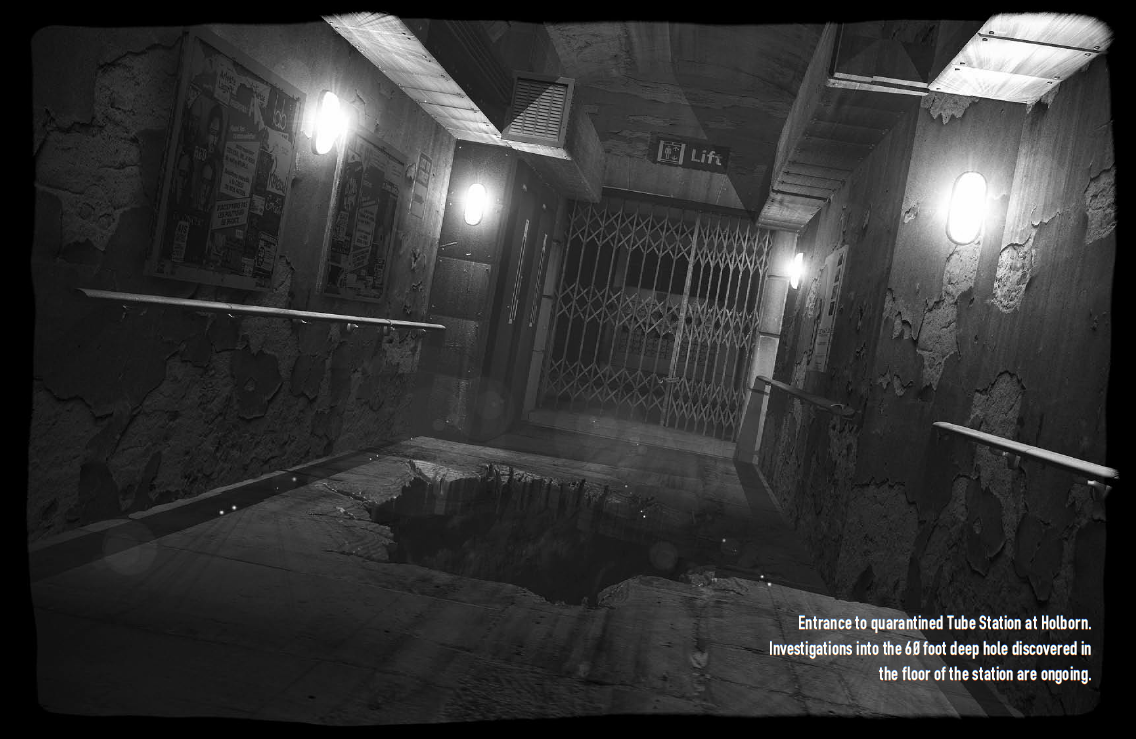
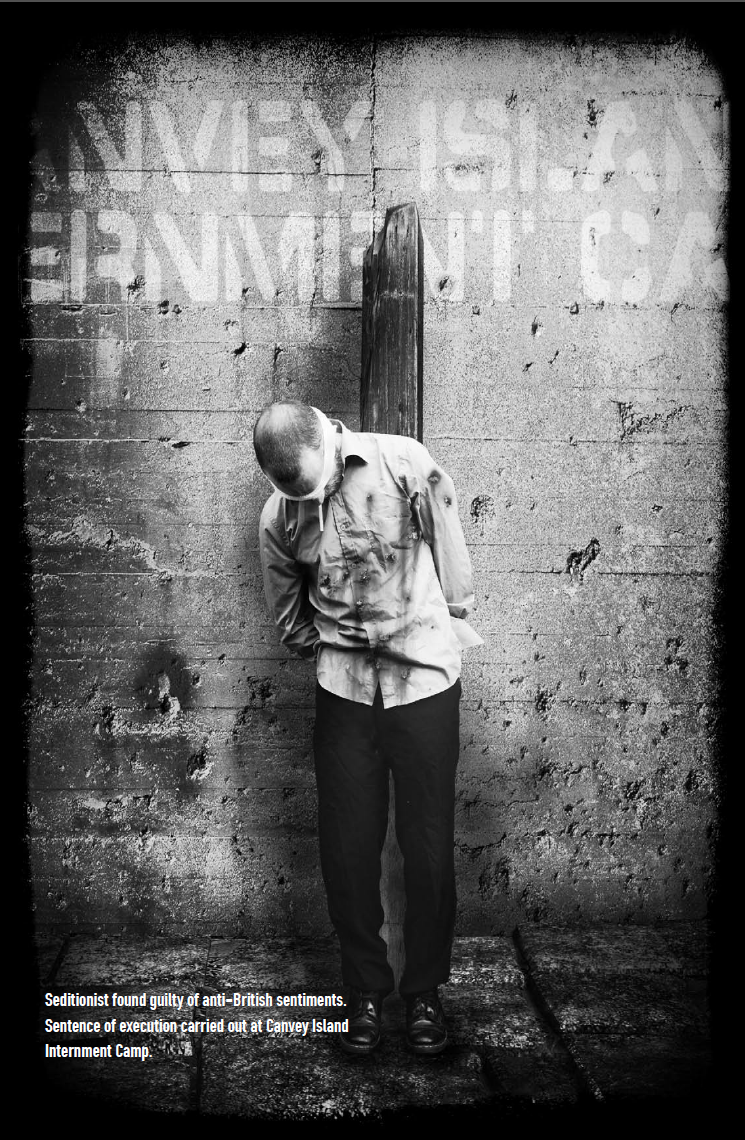
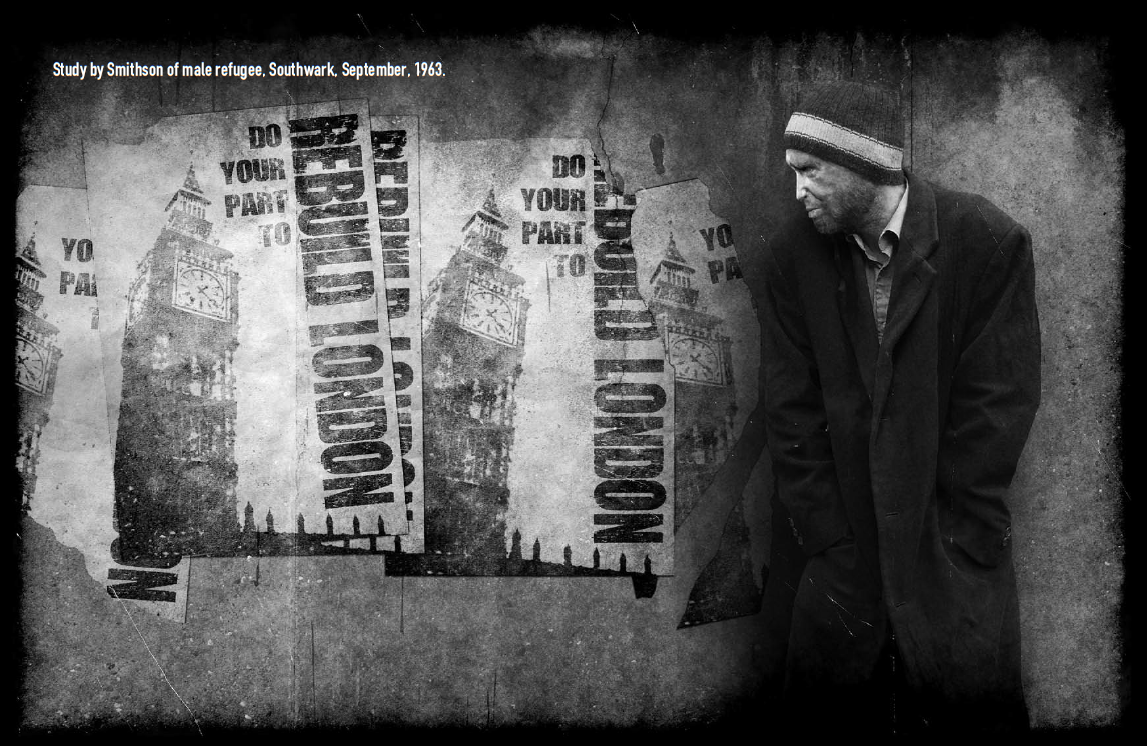
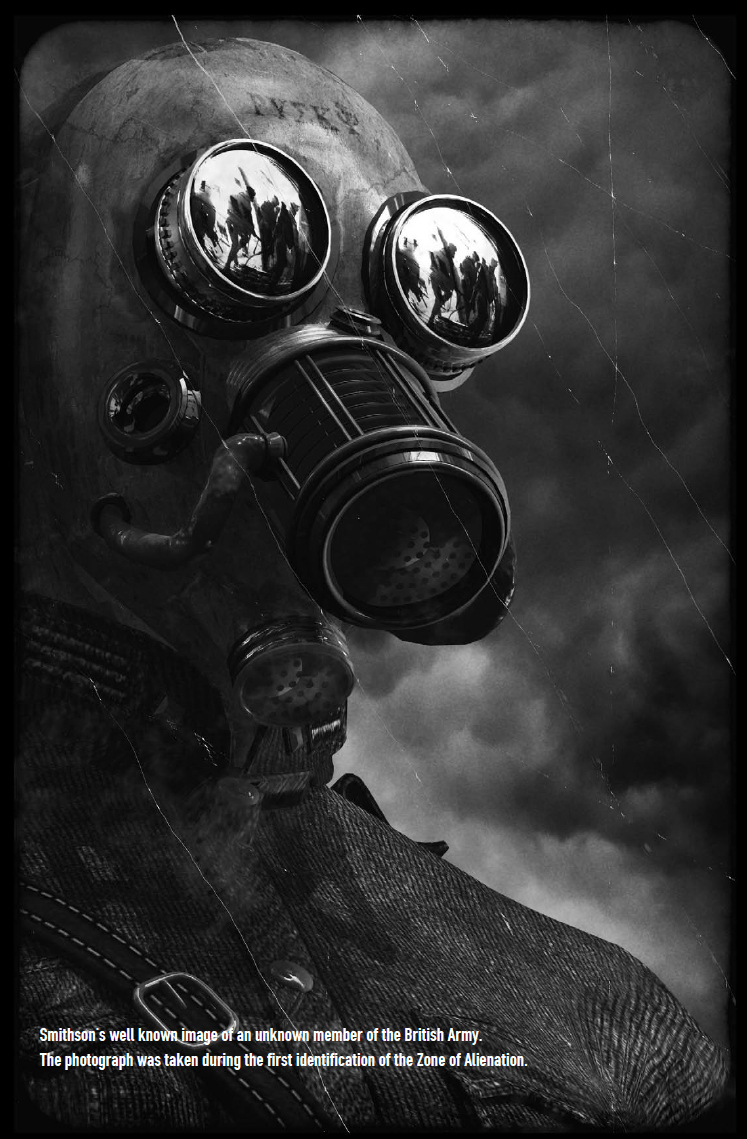
CHAPTER FIVE: ORGANIZATIONS, CHAPTER SIX: LONDON AND BEYOND
Original SA post
CHAPTER FIVE: ORGANIZATIONS
Civil Organizations
British Experimental Rocket Bureau: The Professor and a ragtag group of scientists, engineers and other folks managed to escape Porton Down before INDIGO DIAMOND. The BERB continues its work with the leadership of the Professor and despite the fact that they are one of the most hated organizations in what remains of London. Whatever happened at Porton Down is on their heads, as is being blamed for Windscale (not their fault, explained later) and the general existence of Twisted Technology. A lot of members of the BERB don’t admit their membership due to a risk of alienation. However, they still have a goal and purpose: operate out of Down Street Station and explore/analyze any technology or monster brought to them by the SSG. They’re still the foremost experts.
The Government: Harold MacMillan’s Tory government is still holding on despite the collapse of civilization, albeit with a precarious grip. The war has caused massive restructuring and cutting of departments, changing the government to a much simpler form. On top is Harold McMillan, Prime Minister. Beneath him are three government departments: the Ministry of Food (and water and transportation of such goods and health), the War Office (the armed forces, the police, and matters of refugees) and the Ministry of Public Buildings and Works (rebuilding infrastructure, maintaining it and other matters of refugees). The government also has the elderly Sir Winston Churchill who they use as a symbol of hope by occasionally having him tour London. The three departments are constantly fighting over supplies and favor and as a result the government hasn’t been doing much. They are desperate to maintain the image of control.
The Trades Unions: The remains of the Unions have taken to rebuilding and fixing where the government isn’t focusing. They’ve also taken to protesting the army and the harsh nature of control the military and government have put on the survivors. While the Unions as a whole are helping keep communities together, they’re viewed with suspicion by the government and the military. Some groups have been helping surviving Soviet forces by providing assistance or safehouses and have gotten caught doing so and that’s put them all in the spotlight for scrutiny. Not helping matters is that some groups are completely benevolent and dedicated to helping others and their lack of any evidence against them just makes the government more paranoid. The biggest and loudest of the unions are monitored constantly.
The Union Movement: Not an actual union but an ideology lead by Sir Oswald Mosely, the Union Movement is a right wing group that is becoming uncomfortably popular. They are anti-refugee, fascist xenophobic racists who even want to expel any born British of color or foreign heritage and would like to see them all loaded on a boat and sent to Europe. The goal of the movement is to install martial law under their control, rebuild the military and navy and then invade Europe and take it over to rebuild the Empire. This is an awful idea run by awful people but it’s getting popular thanks to basic arguments of appeals and capitalizing on the fears of the survivors.
Military Organizations
The Army: Most of the Army is actually made of conscripts and National Servicemen who won’t be leaving any time soon. This has lead to friction between the surviving career soldiers/brass and the NS. Mix this with the fact that desertion is rampant and now punished with whipping or hanging again and you’ve got a pot ready to boil over. The Army still has power (gasoline, weapons, vehicles, emergency rights granted by the government) but their losses and the emotional toll of fighting nightmarish creatures is causing them to fray at the seams.
The Royal Air Force: The RAF barely flies anymore except to occasionally get a glimpse at the situation in Europe. There’s not enough fuel to keep these flights up (and barely any working planes left) and as a result the upper leaders of the RAF are terrified of being eaten up by the Army. Not helping matters is that the Army, Navy and government are being bitchy and excluding members of the RAF from decision making and important choices. As a result, the RAF is trying to rebrand itself as a badass group of Twisted Technology specialists and monster hunters, attempting to push the BERB out of the way to take over. This isn’t going so well (mostly because they don’t really have any qualifications) but the RAF does have supplies (ammo, some fuel, mechanical parts, engineers).
The Royal Navy: The Navy has a lot of things going for it at the moment. It has access to offshore oil still, a nuclear submarine in the Thames providing some electricity, a cruiser on the Thames that can provide artillery strikes and an Admiral in the government who favors funding them as the best defense between Britain and Europe. What don’t they have? Well, importantly, they don’t have any means to reliably maintain everything they have. Most Marines and seamen are driving around in small flotillas made of commandeered and patchwork vessels, the ammunition for the cruiser isn’t infinite and they’re only able to keep one ship in good enough shape for an emergency battle. The Navy is slowly rusting away and there’s nothing they can do about it.
Soviet Forces: It’s a bit of a misconception (or incorrect hope, depending on who you ask) that all of the Russian invaders died. Most of the troops were paratroopers shot down or captured when they tried to take key locations or handlers for the monsters and weapons. Overall, there were a couple thousand troops with the majority of them dead by 1963. A lot of them aren’t bothering fighting anymore, lying about their heritage and keeping their heads down. The rest are keeping the fight alive, attempting to use guerilla warfare, infiltration or espionage for a country that might not exist anymore.
United States Combined European Command: The USCEC is made up of diplomatic staff, US Air Force, intelligence agents and other Americans who were trapped in Britain. They don’t have much going on besides trying to find out how America is doing and they don’t have a lot of manpower or resources. For the most part, they help the SSG just to have something to do outside of brokering refuge for American civilians also stuck in London. They’re on good terms with the government, but things are starting to go a bit sour for one reason: the refugees. The USCEC doesn’t agree with how Britain is treating refugees and because the USCEC has St. James’ Square for living, they have room to host refugees. They’ve been using forged documents and names of likely deceased American citizens to make new identities for refugees to redirect them to St. James instead of a camp. The government knows they’re up to something but hasn’t been able to stop the Americans from interfering due to infighting and incompetence.
Police and Paramilitary Organizations
The Citizens Defense Army: The CDA are fighting what they perceive to be oppression of the people and mistreatment of refugees. They operate in scattered cells that have no knowledge of the greater group and go about fighting in their own ways. The main issue with this is that some of the cells are using terrorism, violence and bombings to get their messages across and there’s nobody to rein them in or make a statement about them. They have some support from the people of London (especially among refugees) but there’s the fear that they’re becoming stronger as a paramilitary force. Someone is training them for using their weapons and helping them procure more ammo and explosives and the main line of thought is that Army deserters are giving them a knowledge/inventory advantage.
London Police: Post-war, the Transport Police, Metro Police and City of London Police operate under the label of Police for the government. They broke out old reserve pieces and have since armed themselves with rifles and revolvers, traveling in groups of three to patrol London. From the outside, the London Police is a faceless tool of authority or tool of oppression, either helping or getting more corrupt by the day. On the inside, the police are falling apart from infighting over who is in control of what due to three command groups being mashed together into one. The police are splintering into factions over who is responsible for what with no current compromise in sight.
GK-11 Field Regiment: GK-11 was responsible for the engineering and research done towards Twisted Technology. As a result, a good deal of them came ashore with their monsters and tools to deploy and control them. This didn’t pan out well; GK-11 was almost completely destroyed by its own hands and now exists in small pockets trying to keep the war going.
CHAPTER SIX: LONDON AND BEYOND
Under London
The tunnels and structures beneath London, either transportation infrastructure or protection from the Blitz, have become the homes of most survivors these days. There are places to live and to sleep, but some people prefer to live aboveground because the underground is not as safe as one would think. The sewers are clogged and flowing back into the Thames, there’s humidity and stale air and there are just general quality of life issues like cramped spaces, monsters and disease.
The Cabinet War Rooms: The War Rooms were where Churchill originally helped lead Britain during the Blitz. Up until now from the end of WWII, they were abandoned due to some inadequacies (low ceilings, very humid) before they were reclaimed by the government. The Prime Minister and the rest of the government (except the RAF) live here now in these secure concrete rooms and try to lead the country back into safety. Rumor has it most occupants are too afraid to actually go out into the world.
The Deep Level Shelters: The Claphams, Stockwell, Oval, Goodge Street, Camden Town, Belsize Park, Chancery Lane and St. Pauls’ air raid shelters are near the Underground stations. They are deep belowground in three mile long tunnels to hold 8000 military during the Blitz. They did their jobs and were promptly abandoned for 20 years and once again the military occupies them. The rank and file soldiers hate the shelters despite the safety; they’re badly lit, badly ventilated and humid and with those conditions it wears on one’s mind. Chancery Lane, Goodge and St. Pauls’ get some more information than the others. Chancery was a telephone switchboard nexus, Goodge was abandoned to monsters and is now an empty slaughterhouse and St. Pauls is where the military tortures and interrogates suspects (leading to the informal term of “St. Pauls Hobble” regarding the way people walk while recovering from broken ankles or knees).
Down Street Station: Originally abandoned, it’s now home to the SSG. Kids and teenagers can find food and employment around the station by working the ventilation pumps to keep fresh air cycled through the station. The other upside of Down Street Station is that not everyone lives underground; the SSG has commandeered the use of some nearby apartment buildings for living and provide electricity to them with pedal generators.
Post Office Railway: The Post Office Railway’s original purpose was to provide an independent means for mail to get around without running into traffic or delays. The railway uses electric trams and a smaller span of tunnels than the regular underground. Now the railway is a legitimately secure means to get around London under the nominal control of the post office and the less official control of the Army. The entire line is secure from the rest of the tunnels so anyone who curries favor for a ride can get an actually safe trip.
The London Underground: The Underground was the first place people turned to for safety in 1962. For a while the Army used the tunnels to ship troops and get around. While secure at first, they quickly proved to be killing floors for the creatures that could get inside. The Underground as a whole is abandoned with some places used for storage. The tunnels are generally unsafe; water floods some of the tunnels, barricades and detritus try to cordon off tunnels and have made old maps hard to use and electricity is unreliable. Most Londoners don’t risk exploring the tunnels anymore, having heard too many ghost stories about cannibalism, madness and monsters.
CENTRAL LONDON
Central London is marred with makeshift barricades created from trash, rubble, old vehicles and military wire. They are rarely useful for actual defense, constructed mostly to provide the image of protection.
The Admiralty Citadel: The Citadel is the home of the Navy, a concrete building covered in poles and wires. The Navy maintains its own network of cables that lead to its installations and refuses to let any other military force into their building for any prolonged period of time. The building is heavily fortified and easily defended, making it one of the safest places in London.
HMS Belfast: The Belfast was supposed to be decommissioned and scrapped in 1962 but the war interrupted the planned retirement. Because it was supposed to be taken to be destroyed and was not viewed as a target, it was actually in working condition to sail down the Thames and provide artillery support. Now the Belfast is the sole guardian of the Thames and Central London, supplied by many boats making runs to it and occasionally shelling neighborhoods and monsters. But the heavy munitions are running out, and more importantly the Belfast hasn’t been maintained in a while. It needs a full yard to give it an overhaul and that’s not guaranteed to happen.
HMS Dreadnought: The Dreadnought is the famous nuclear submarine of the Navy, tied up on the Thames and using its nuclear reactor to as a power source. While the power is nice, the problem is the technicians and nuclear scientists. The remaining few capable of keeping the Dreadnought running properly have been taking advantage of their necessity for food and shelter and it’s making other members of the Navy angry. Plus everyone around knows that if something to happen to the Dreadnaught, the Navy’s power would be hindered and it’s become a tempting target.
Yanktown: St. James Square is home to the previously mentioned USCEC. Yanktown has privileges other neighborhoods and refugee camps are jealous of: they can keep their guns and mostly police themselves. Yanktown is also growing thanks to members of the USCEC fudging identities to try and save refugees from the camps and it’s getting a bit crowded.
GREATER LONDON
The Dogs: The Isle of Dogs was not a good place to live before the war and it’s only gotten worse. The Isle is a mess of buildings, dockyards and warehouses, all of them decaying and becoming a haven for bad people and monsters. The Army and the Police rarely touch the Isle because they know they can’t effectively do anything for the area (or maybe they just don’t want to). There are still good people or stubborn people, but they live on the outskirts of the Isle and refuse to leave the area. They make a good source of information about the things living deeper in the maze of rotting buildings.
Frogtown: Most of Southwark has been converted into an area for containing European refugees who fled to London during the first few weeks. A lot of them have been made resident aliens thanks to paperwork and timing, allowed to possess weapons and police their area. They get the name Frogtown thanks to slurs and the fact that a lot of the refugees are French survivors (mostly farmers and fishermen). The residents of Southwark don’t make much trouble and are useful for the government as a labor force, but there are concerns. Some of the refugees are considering taking up the USCEC’s plan of helping save other refugees out of a sense of compassion while others don’t want to rock the boat just yet.
Woolwich Arsenal: The arsenal is (of course) run by the Army, full of stockrooms of materials and old factories to make weapons and munitions. Unfortunately for the Army, the supplies aren’t infinite and they only have so many workers and scientists who remember how to make cartridges and explosives. The increased pressure on the manufacturers and the growing deficit of materials is making things tense, resulting in Army officials breathing down the necks of workers who literally can’t fulfill their requests. The Army controls the base with an iron fist and is growing more paranoid by the day.
NEAR LONDON
Dengie Peninsula: North of the Thames and on the east coast is a supernaturally silent graveyard of rotting ships. The peninsula was full of smaller towns and marshland but now it’s the home of rusting Soviet hulks, the same ships used to carry weapons ashore. And the weapons haven’t left, transforming the ships and marshes and abandoned towns into nests. The area is also home to some foolish/tenacious Soviet soldiers/researchers and the occasional scavenger trying to get fuel or technology. There are also rumors of gates and portals that are still open that might lead to Russia or places beyond space and time.
The Internment Camps: Refugees are still coming from across the isles and from Europe, traveling by boat or foot just to be rounded up and held by the Thames estuary. The government is paying nominal attention to the camps, focusing more on the surviving Londoners and letting the camps get crowded and underfed. The camps are not good places to be, full of desperate people who managed to survive and the human monsters among them. There are four main camps:
- Canvey Island: A barbed-wire enclosure with collapsing wooden structures, Canvey Island was supposed to be a transit camp for moving new refugees to the other three. Now they barely bother moving people to the other camps, letting Canvey Island get just as full.
- Cliffe: The smallest camp was originally designated for people the government could find useful but couldn’t accept yet. Cliffe is full of skilled people waiting for interviews living in old cement structures and an old village.
- Isle of Sheppey: Sheppey was the first camp built and is in the worst state, a squalid and filthy place. Fresh water is rare and a group of Belgian scientists have managed to rig a group of bicycles to provide power to a makeshift desalinization plant. It’s not enough water, but it helps.
- Southend-on-Sea: Southend-on-Sea was a resort town converted to a camp. The refugees live in decaying cabins and rooms, substantially more protected from the elements than the other camps. Southend is the biggest camp and just as dangerous as the others.
The Zone of Alienation: North of London, by Essex and Hertfordshire, is a place marked only by crude signs. The Zone of Alienation is home to colors that don’t exist in nature, pockets of augmented time, looping sections of road, terrible visions and mutated wildlife. People have gone in and returned but nobody has ever fully explored the Zone (it’s illegal to go in but the authorities can’t actually stop people). Nobody’s sure what created the Zone but some believe that the Zone’s existence swallowed up the nuclear weapons aimed at London. What people are sure of is that the Zone is growing; they don’t know how fast, they don’t know how or why and it’s even hard to tell when you’ve entered the Zone but they do know it’s growing. Worse still is that the Zone seems to be the source of other creatures and beasts that the Soviets didn’t bring over.
APPENDIX
Well, we’ve reached the end of the book! There’s not much to the appendix; most of it is related media that you could use for inspiration and sheets/primers to share with players. But there are some game ideas too, which I will gladly share here.
BASILISK
Tone: Post-apocalypse.
Something is making the people of London explode and the characters have to figure out what’s causing it. The explosions are not caused by munitions or explosives; something is just causing them to detonate violently and die. The terrified public has dubbed the source of the explosions The Basilisk and the fear is leading to unrest, causing more rumors of legendary and mythical monsters to sprout up and scare people more. The characters also have to work with the Army to stop the Basilisk and the Army wants nothing to do with it, not thinking of it as their business despite having big enough guns to put an end to the explosions.
The Basilisk actually is a Soviet weapon, a living organism that causes people to explode when it looks at them. The design behind it was to activate it as a sleeper weapon so eventually it would cause mass mayhem and death. Its handlers activated the Basilisk months after the war and it immediately killed them before wandering off. It’s not a smart creature, simply an animal with bizarre and dangerous powers.
Other NPCs and Groups:
- Lt. Ernest Folland: CO of the Army assigned to helping the characters. Folland’s only doing this job because he thinks it’ll get him a promotion if he uses the minimum amount of men and equipment. He doesn’t really care about what the characters think, viewing them as idiots wasting his time.
- Colonel Yevgeny Malinin: Malinin was a member of GK-11 and knows quite a lot about their weapons. He only recently came out of hiding to broker a deal with the Navy for protection. While he’s the best shot the characters have of getting concrete information about the Basilisk, the Navy doesn’t want anyone to have access to him until they’re done pumping him for everything he knows.
Tone: Dark Horror.
Disembodied hands have been appearing around London, getting around by dragging themselves with fingertips or walking with their digits. Originally the hands were a minor annoyance or a joke: poking people, dragging things, trying to perform tasks. Now the hands have gotten worse by becoming aggressive and invasive: grabbing people, invading homes, strangling people. The SSG is one of many groups assigned to dealing with the hands because nobody knows where they’re coming from.
Other NPCs and Groups:
- Major Warren Cripps: Cripps is an Army engineer who wants to figure out how to control the hands. He believes they’re being directed by something and if he can find the puppet master, he can control them and turns them into a weapon under his control.
- Ashley Bingham: Ex-MI6 who now works for a shadow group that “advises” the prime minister. She’s sabotaging investigative efforts to keep the knowledge for her group alone and is well equipped and backed for this mission.
- Jeremy Updike: Updike was a postman before the war. He lost both of his hands helping defend London and now he believes that the hands are a sign from God. Updike is not an emotionally/mentally stable man and depending on how the characters treat him he’s either helpful or harmful.
Tone: British Catastrophe
Every day, at 11:11 AM, a handful of people lose their memories. The victims are left stumbling and confused, unable to speak or articulate. Some victims are left to fend for themselves or are cared for by their burdened families or friends. The phenomenon isn’t getting worse or growing, but it’s still happening on a daily basis and that’s adding up. Groups across London are working on their own to be the ones to stop the phenomenon and gain all the glory, but nobody has an answer just yet.
Other NPCs and Groups:
- Dr. Amelia Webb: A biochemist before the War, she continues her scientific work but with a focus on curing the memory plague. Unfortunately for her patients, Webb is a jingoistic xenophobe who doesn’t like continental Europeans. Her experiments are brutal with little care for the patient’s well being because she doesn’t care about what she’s doing to them.
- Sheridan Browlow: Browlow’s whole family has been afflicted with the memory plague and he’s at his wits end from taking care of them, overstressed and overworked.
- Nancy Carter: Carter is a Union Movement activist who is taking advantage of the fear caused by the plague to stir the anti-government pot and get people to join the Union Movement.
Tone: Quality BBC Drama
A local politician who calls himself The Boss is trying to turn a borough into his own personal kingdom. He has turned a group of police into his army of thugs and together they oppress the people of the borough, extort from them, live richly and lie to the government. But someone has noticed and that’s where the characters come in. Their job is to infiltrate the borough, find out the truth and resolve the situation.
Other NPCs and Groups:
- The Boss: The Boss was nobody before they took power, a forgettable politician, a stuffed shirt. Now he believes himself to be more important than he really is, his newfound power going to his head. Beneath his bluster and bravado, he is a coward and a bully.
- The Wardens: The Wardens are the police of the borough and are actually only loyal to The Boss’ right hand man. Should their true leader wish it, they’ll abandon The Boss.
- The Boss’ Wife: The Wife likes her life but hates the obligations and lack of freedom. She’s secretly cheating on her husband with the right hand man.
- The Dupuis Family: A group of refugees who are living in the borough. They will come to the Boss’ attention eventually as the father has a gold watch he refuses to part with and they’re living illegally in the borough.
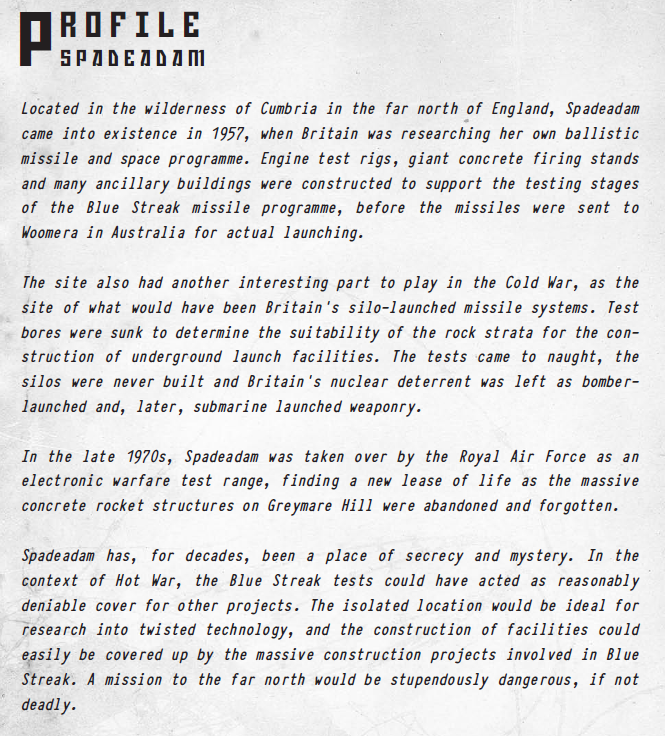
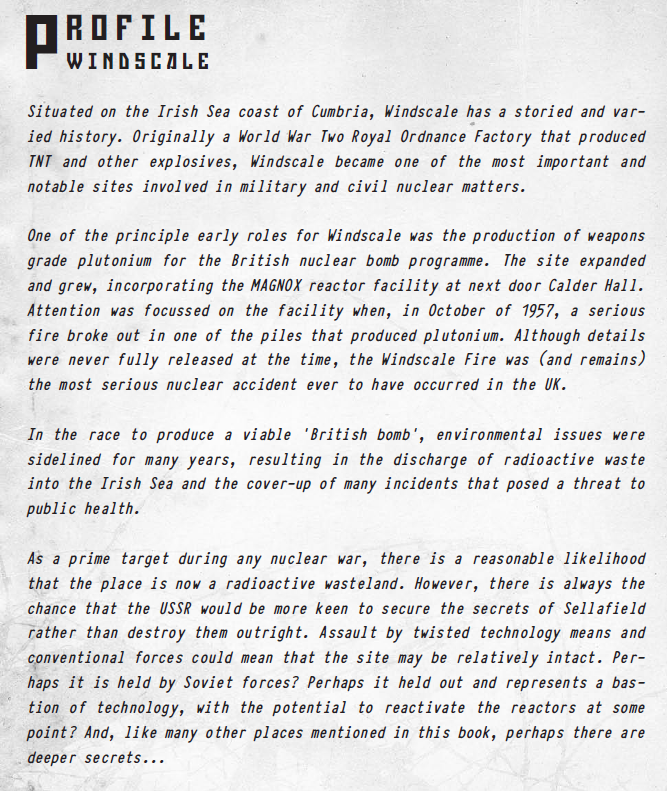
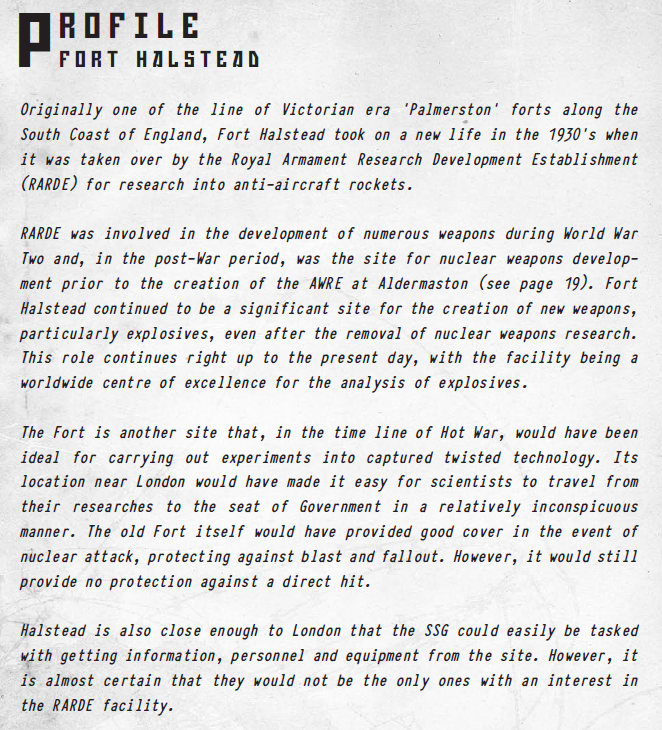
PHOTOGRAPHS
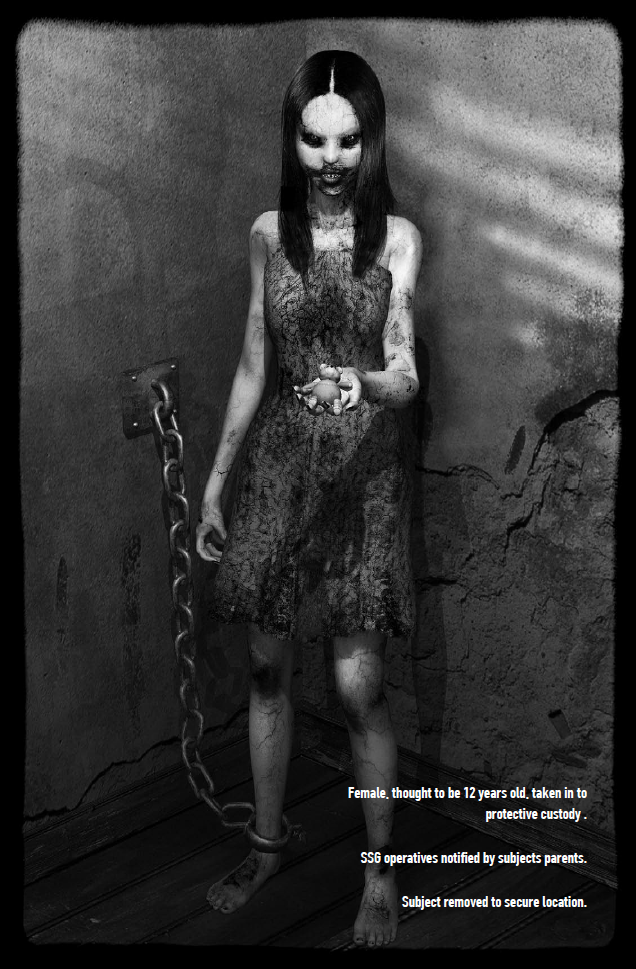
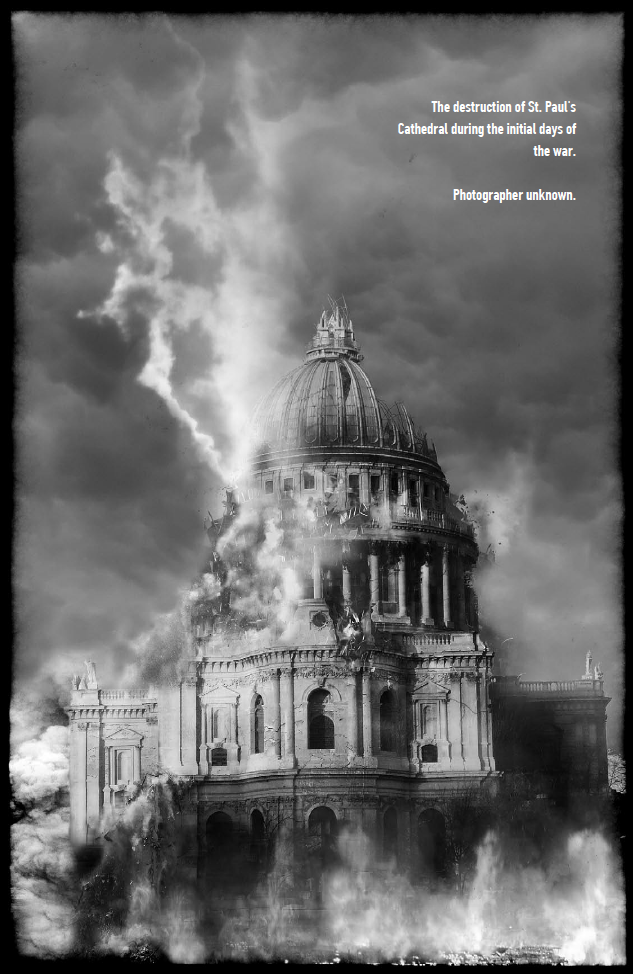
DOCUMENTS, POSTERS, FLYERS
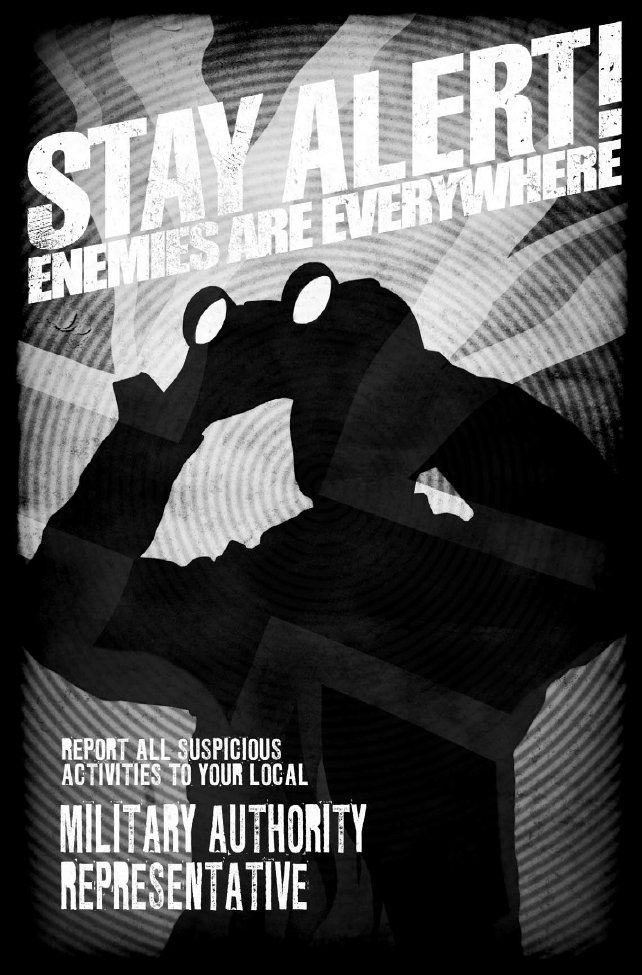
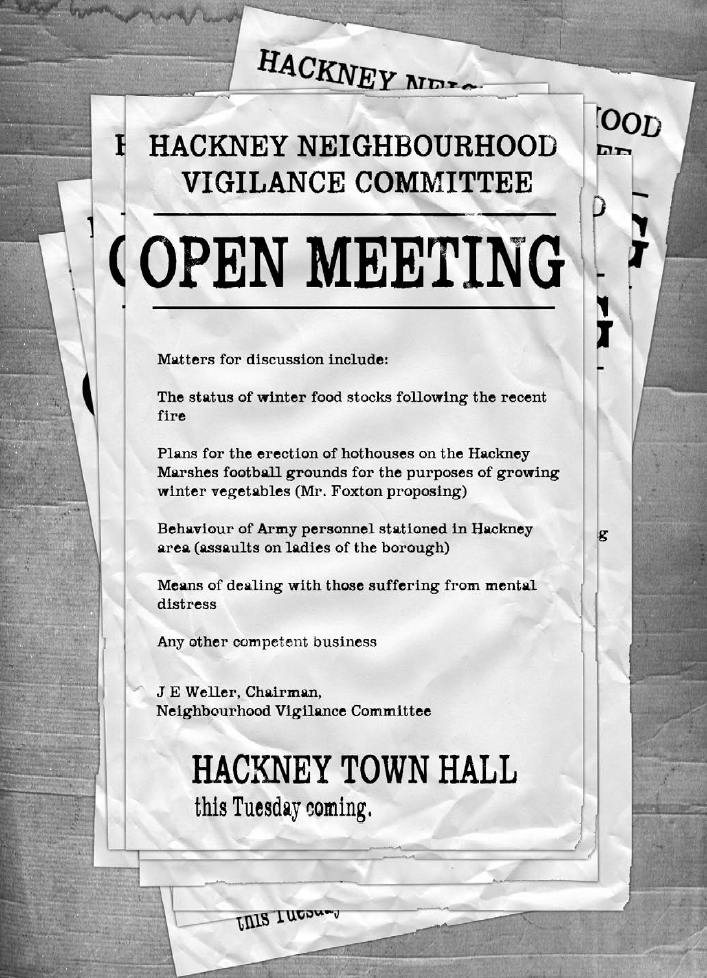
Warning: oblique mention of gross content.
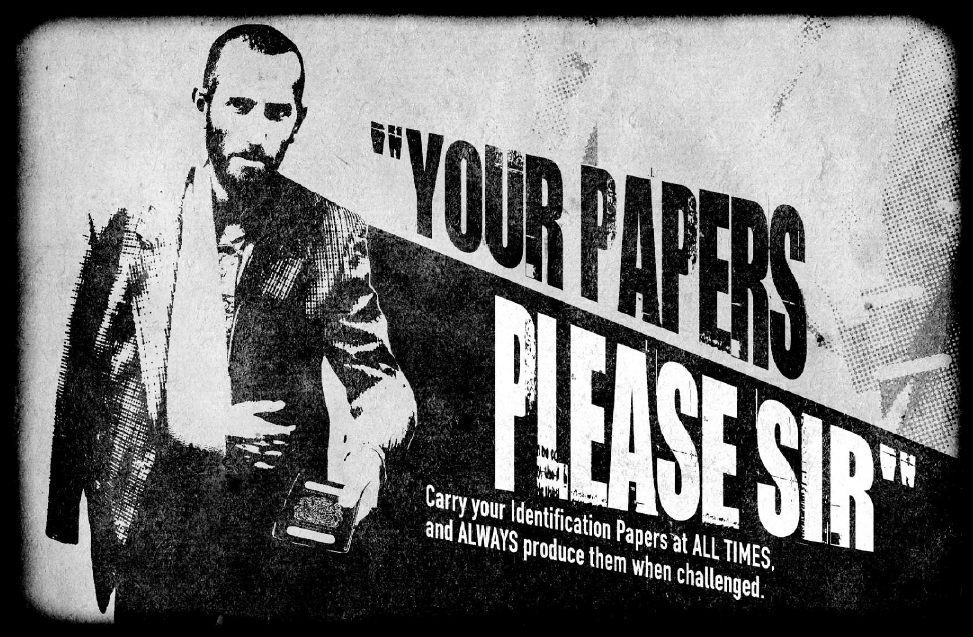
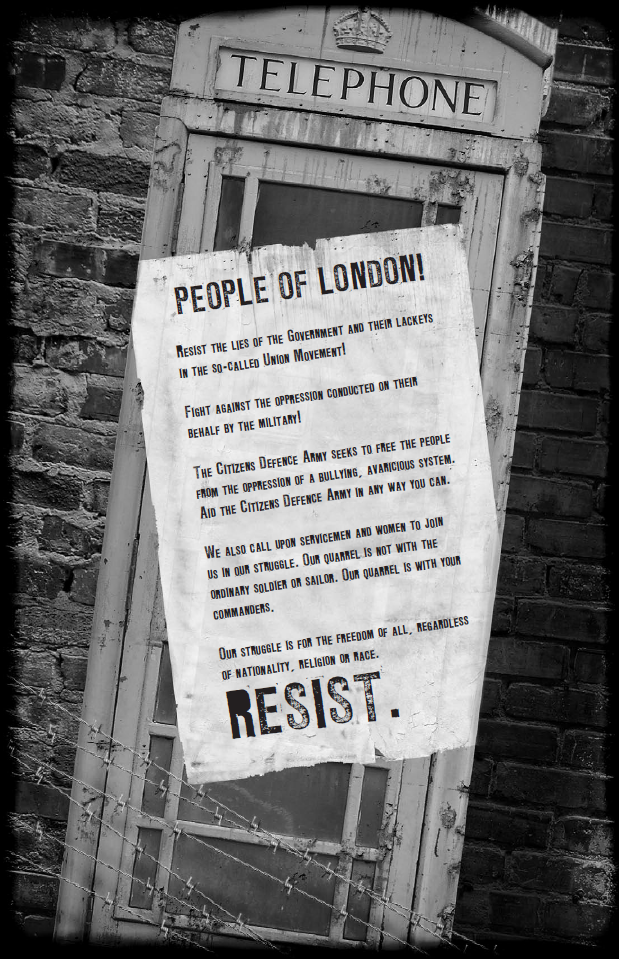
AFTERWORD
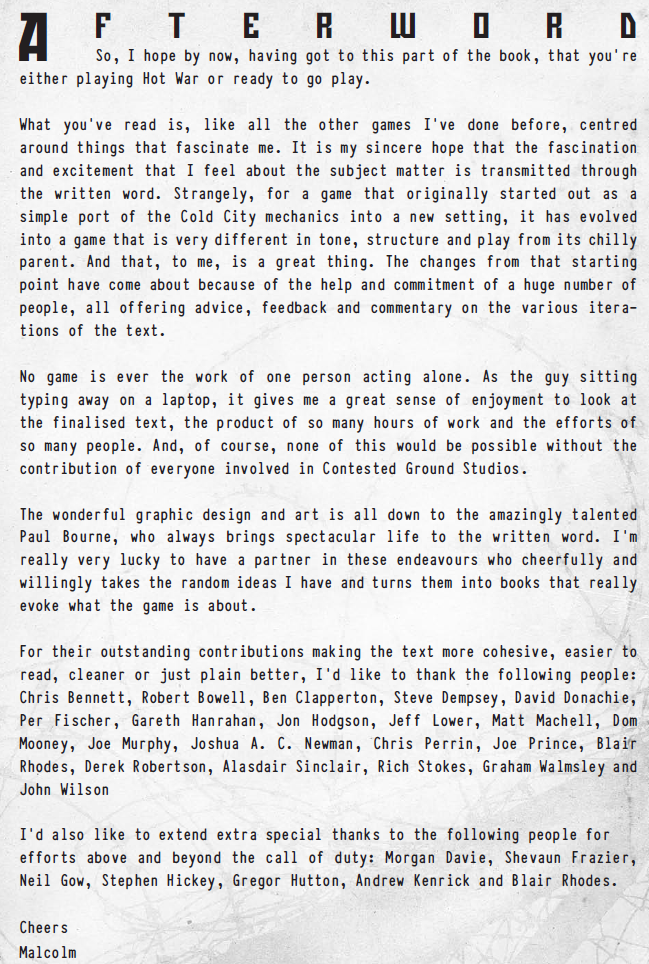
That’s it for Hot War. I feel like it definitely made some improvements on Cold City, especially by opening up avenues for relationships with NPCs and making contacts. It’s also an interesting enough take on a post-apocalypse for me. I like the open nature for what happened and how the players and GM should figure it out together, it works well with the mechanics. Above all else, I still really enjoy the epistolary nature of the world and the detail that went into the fake documents. Thanks for reading along!